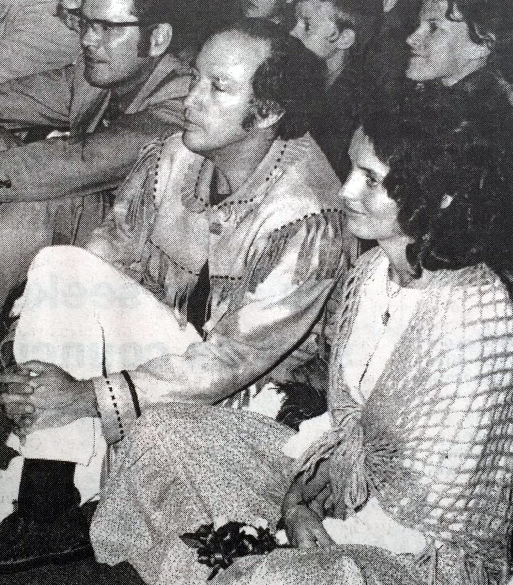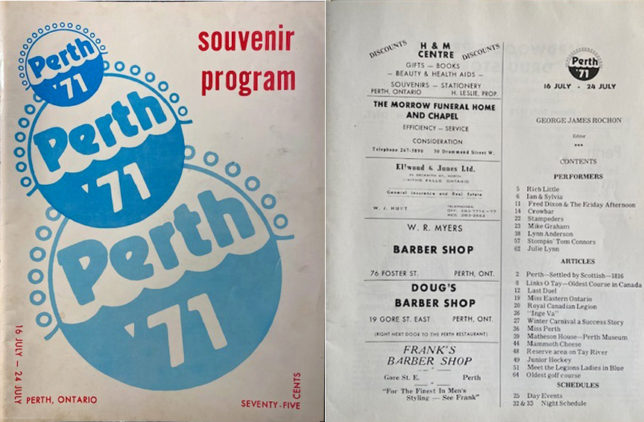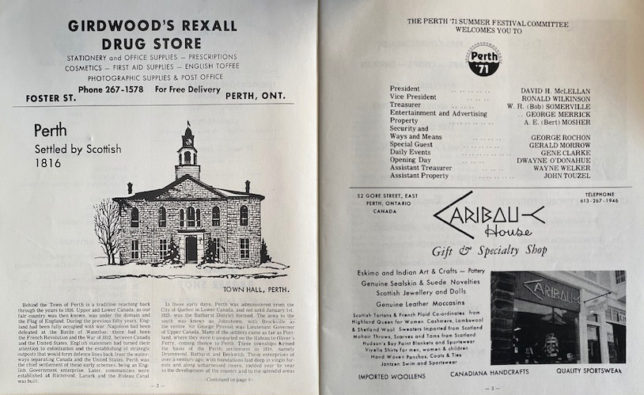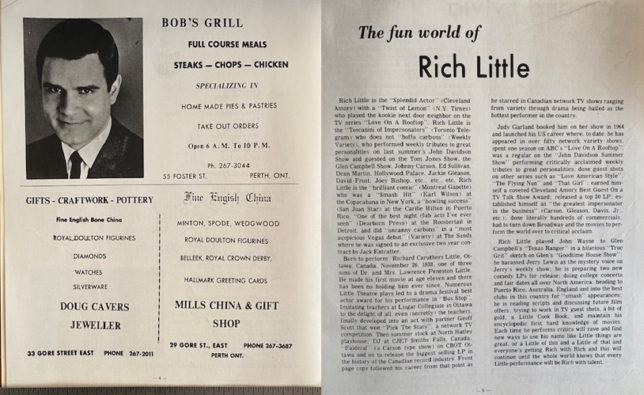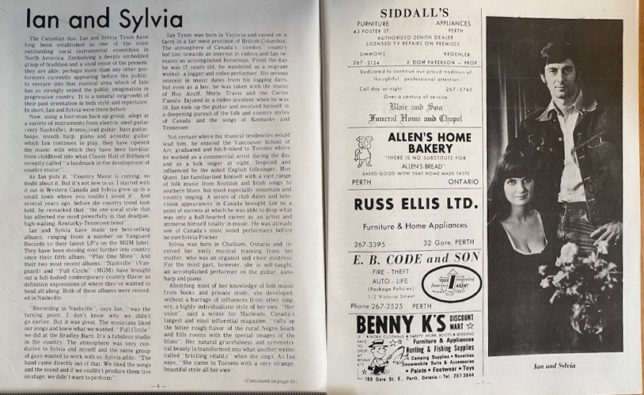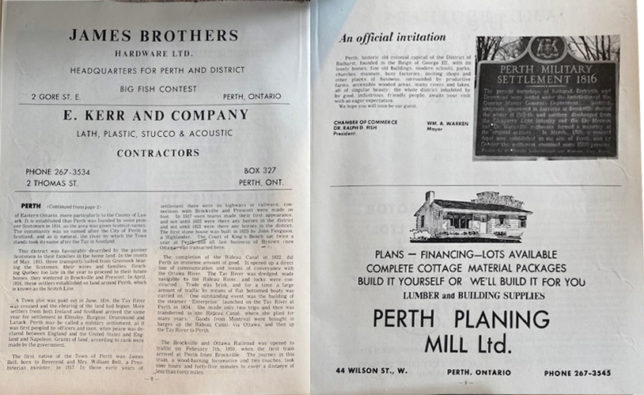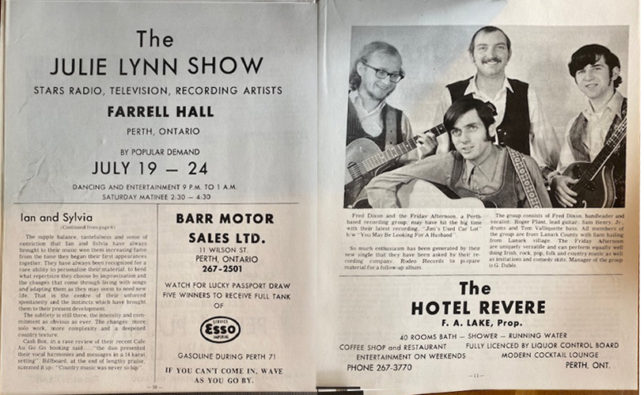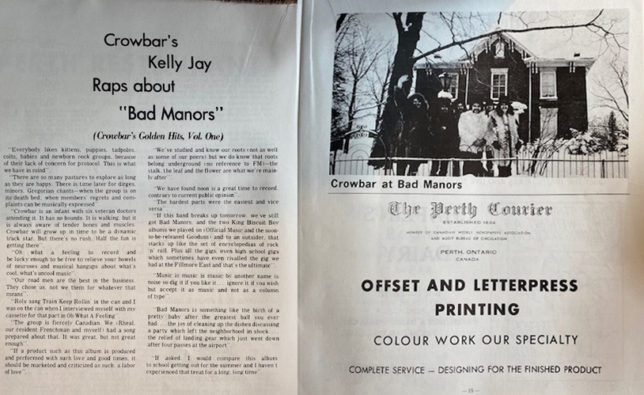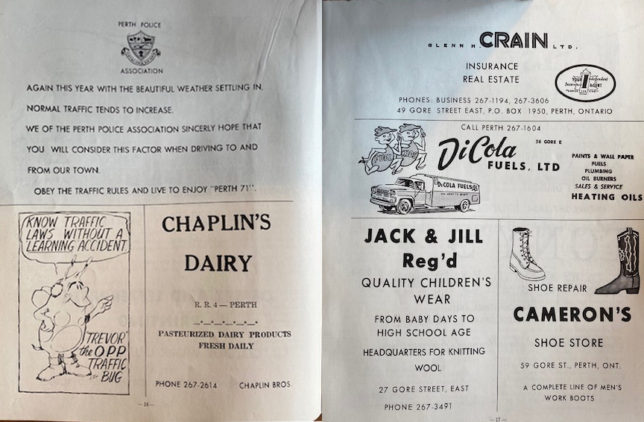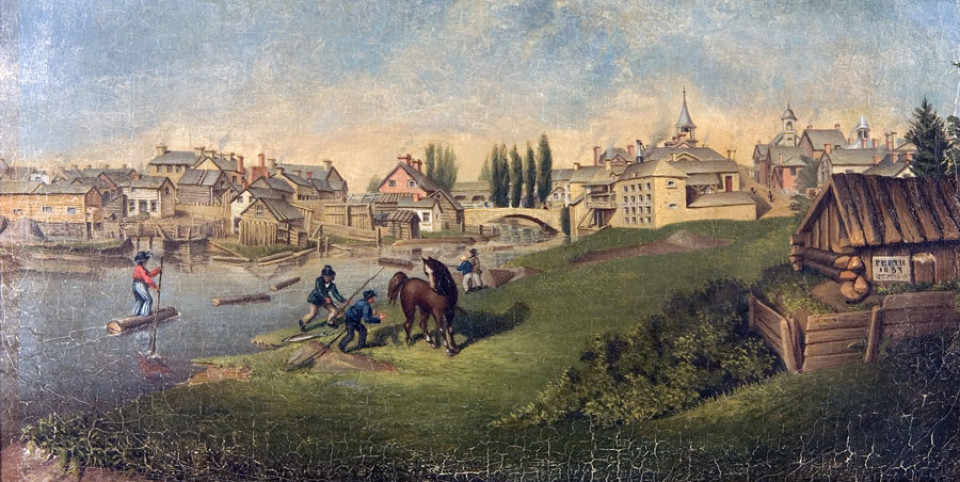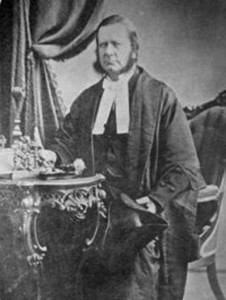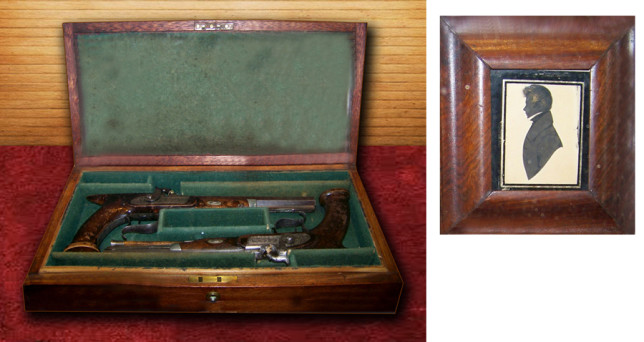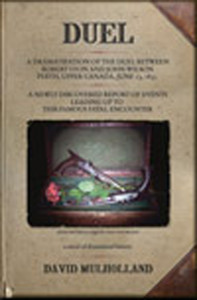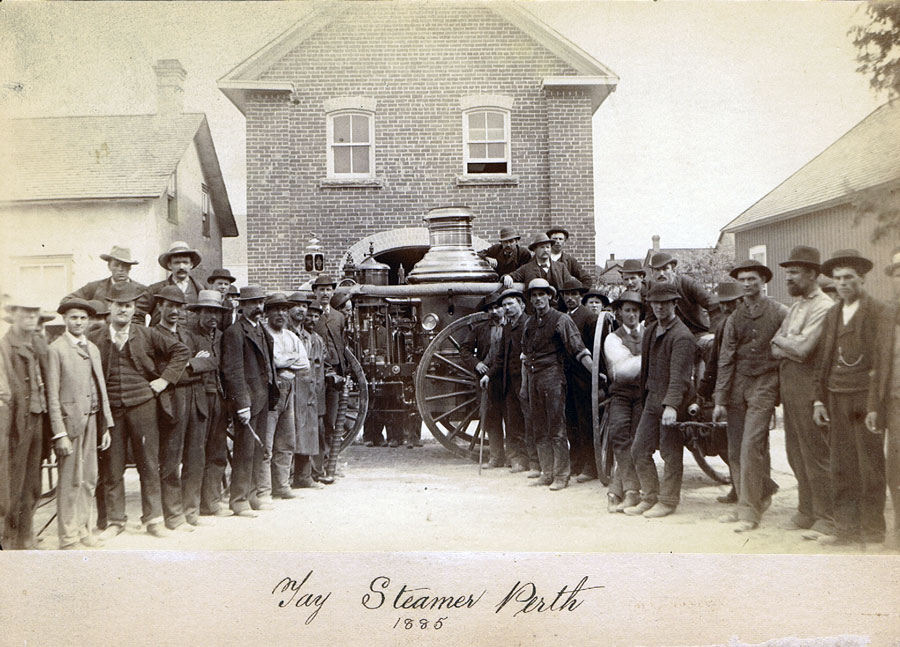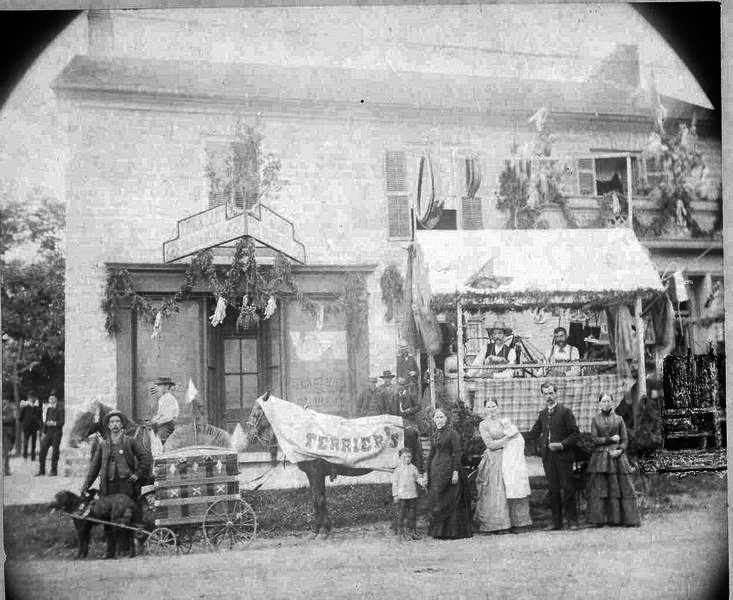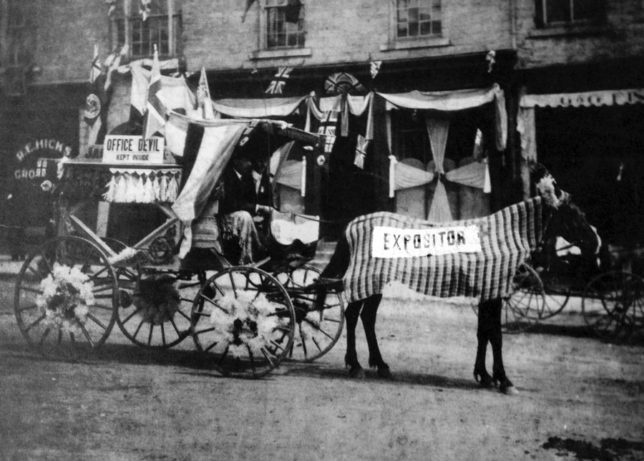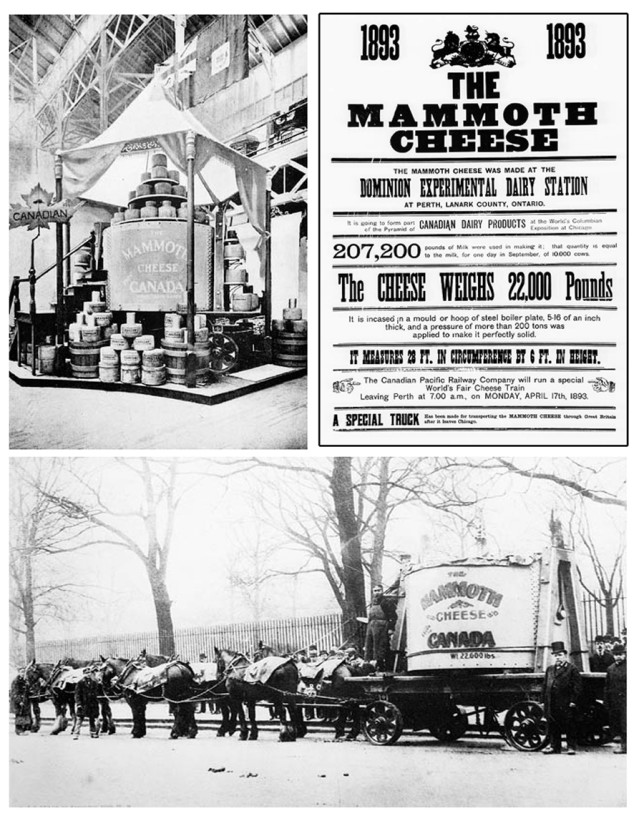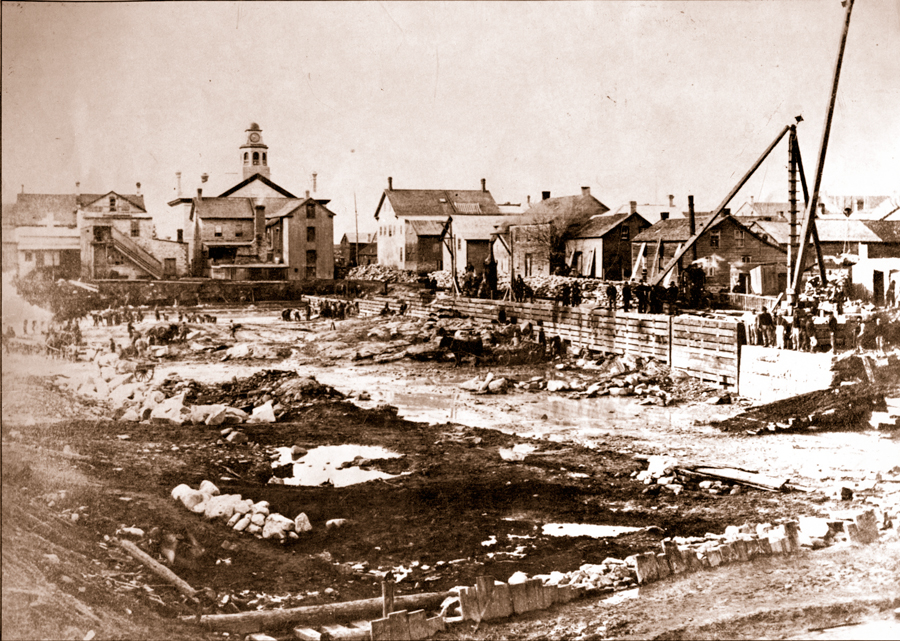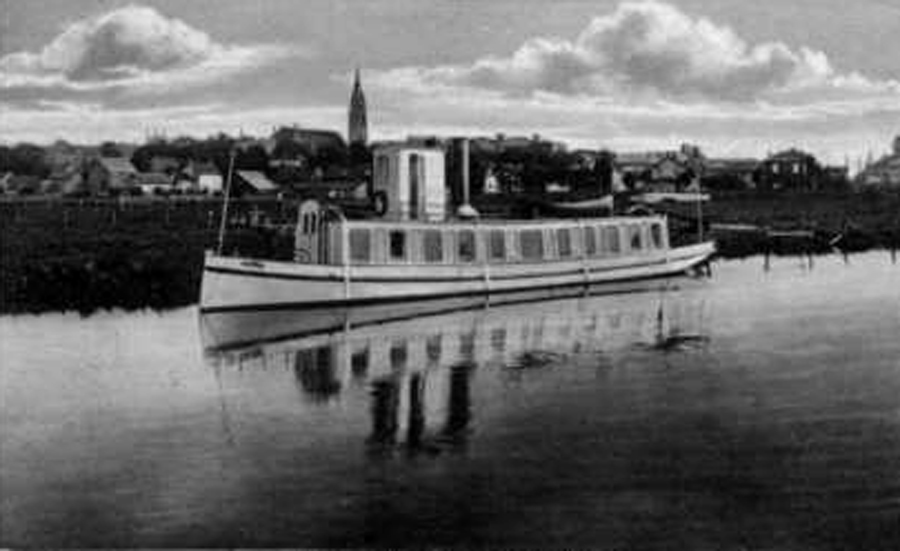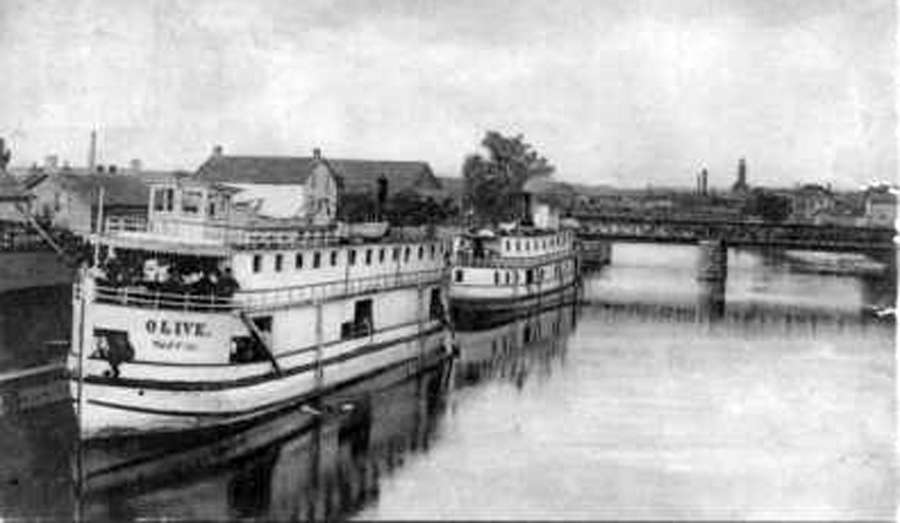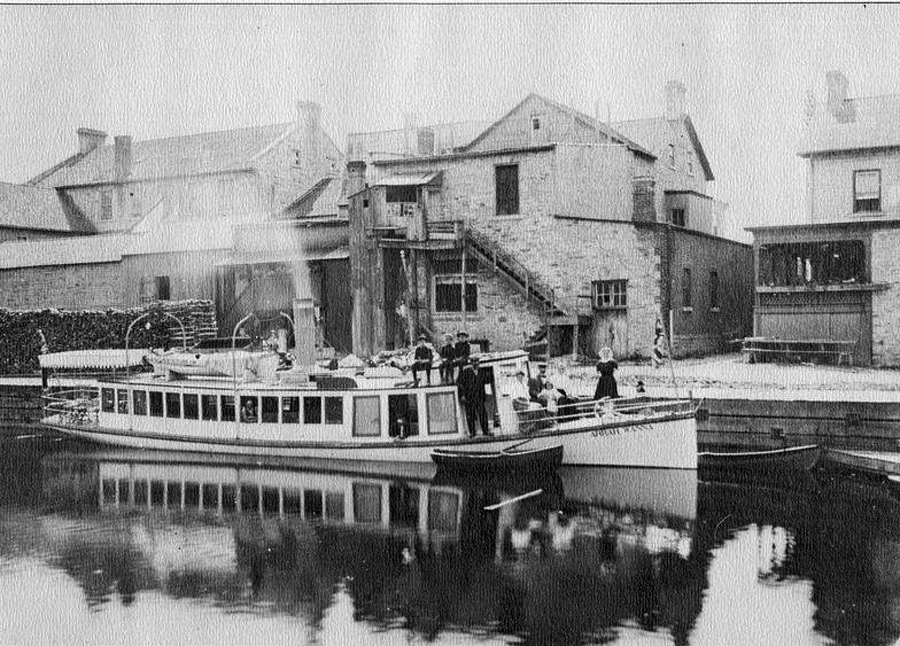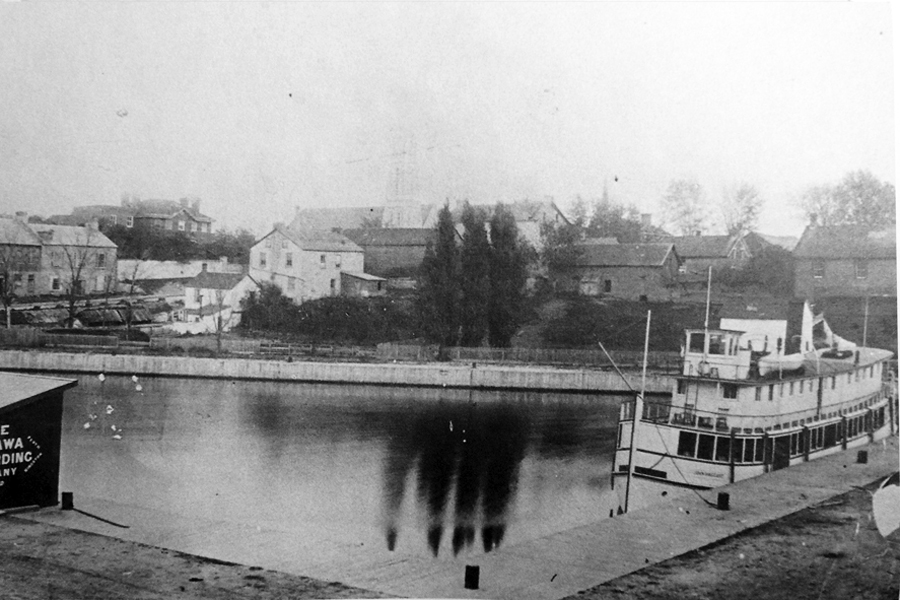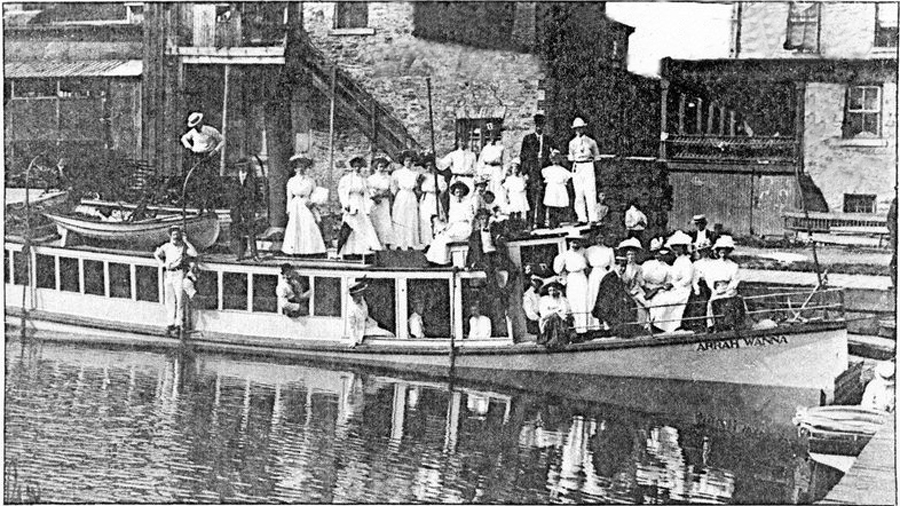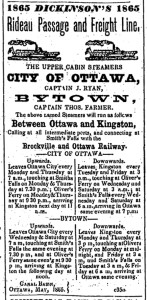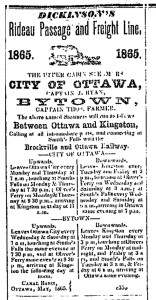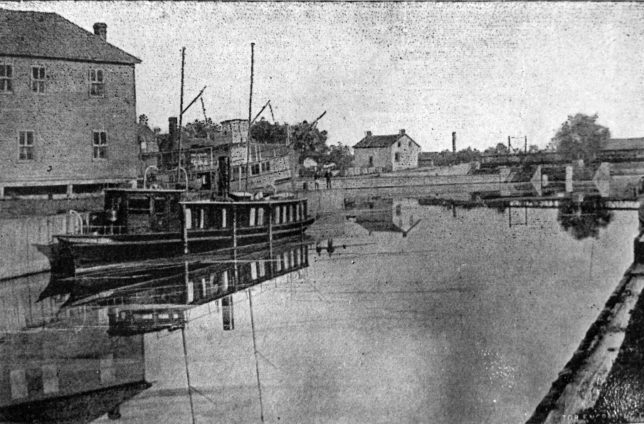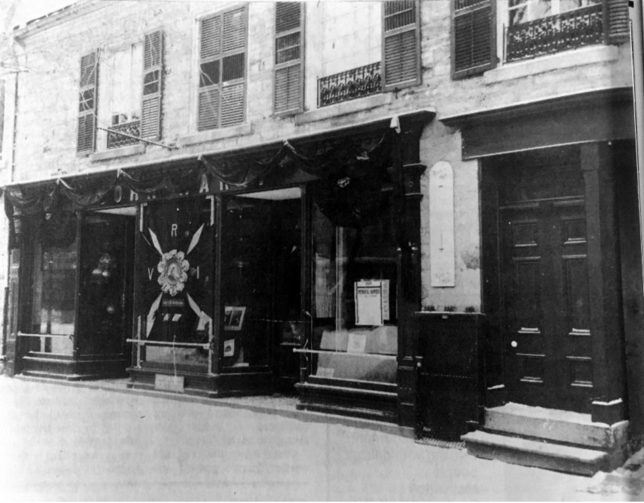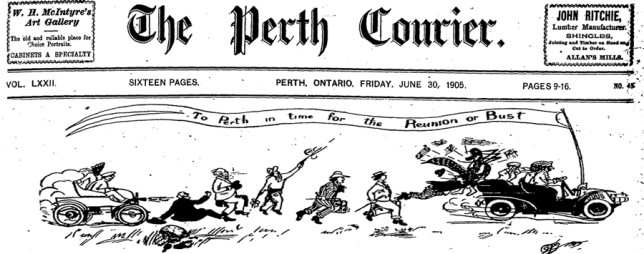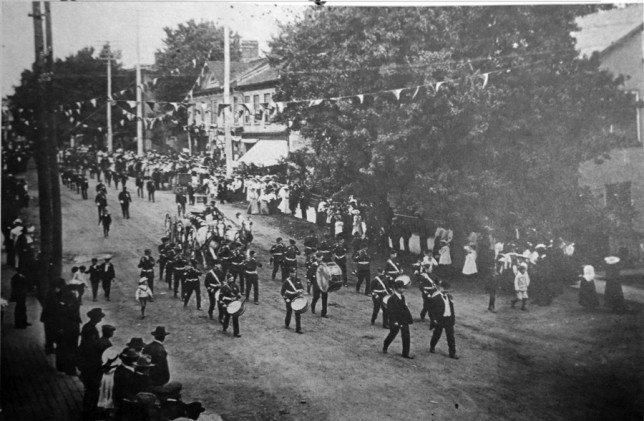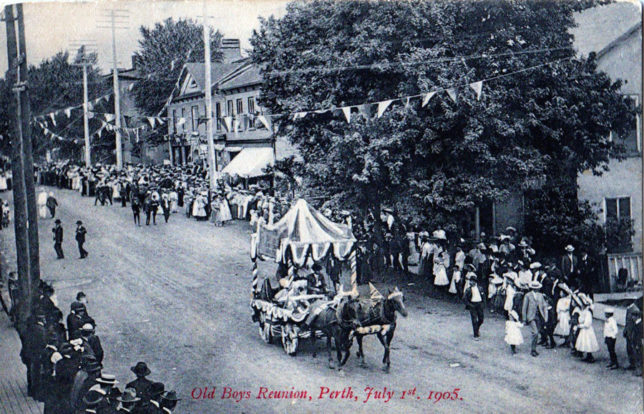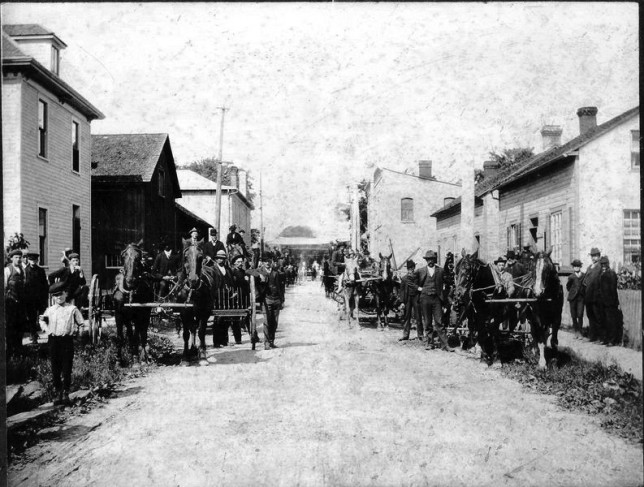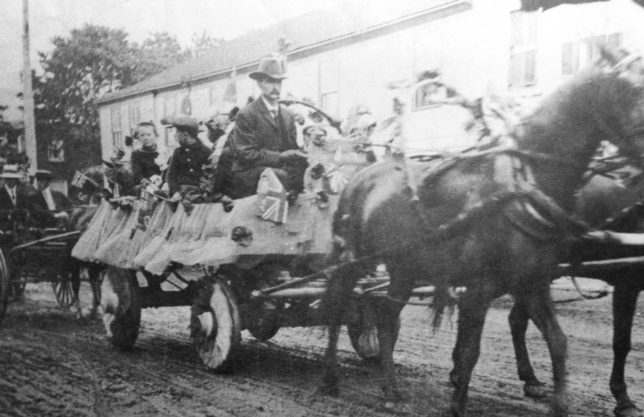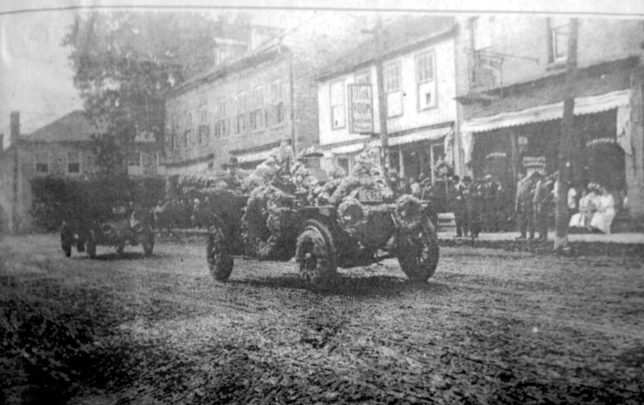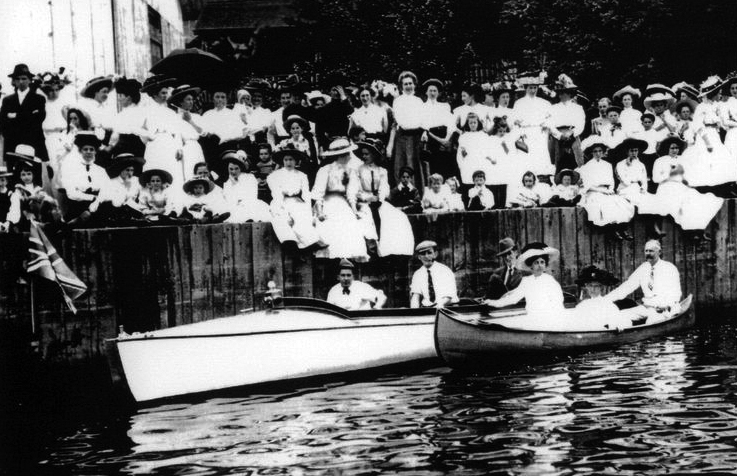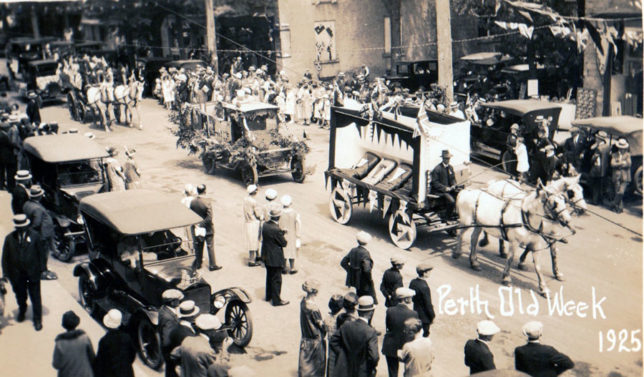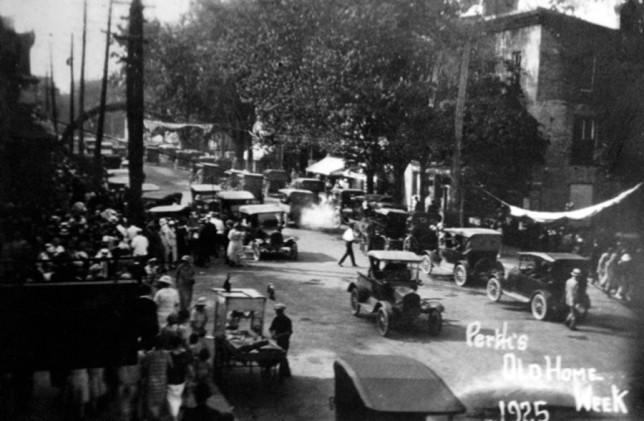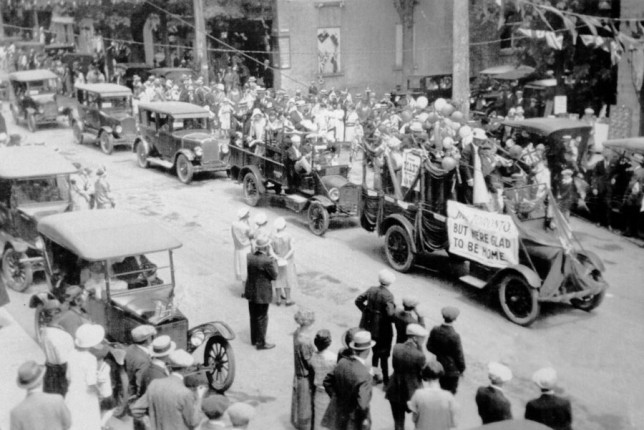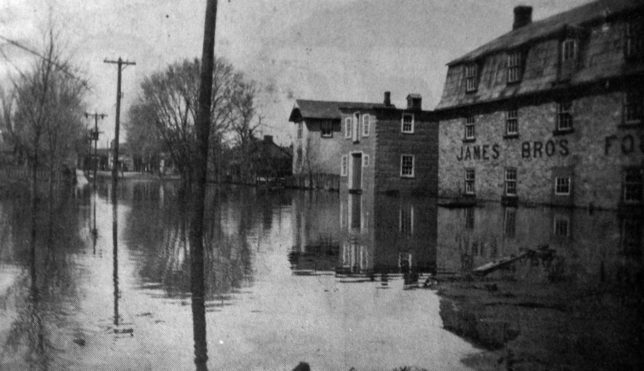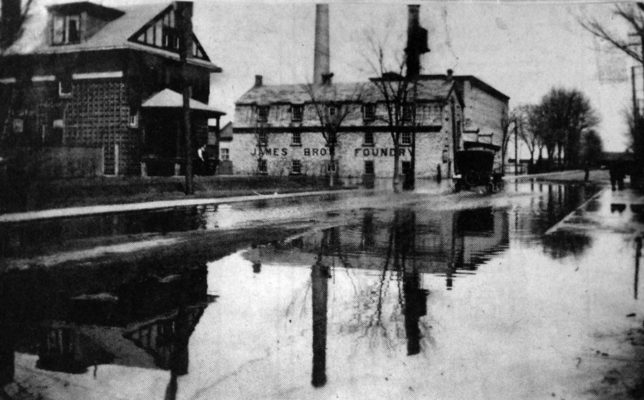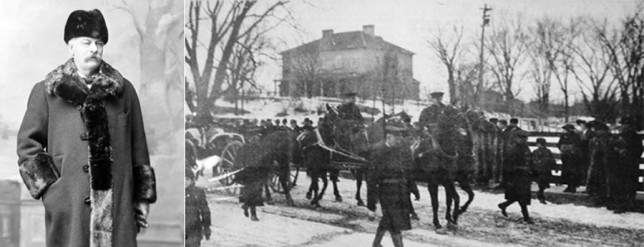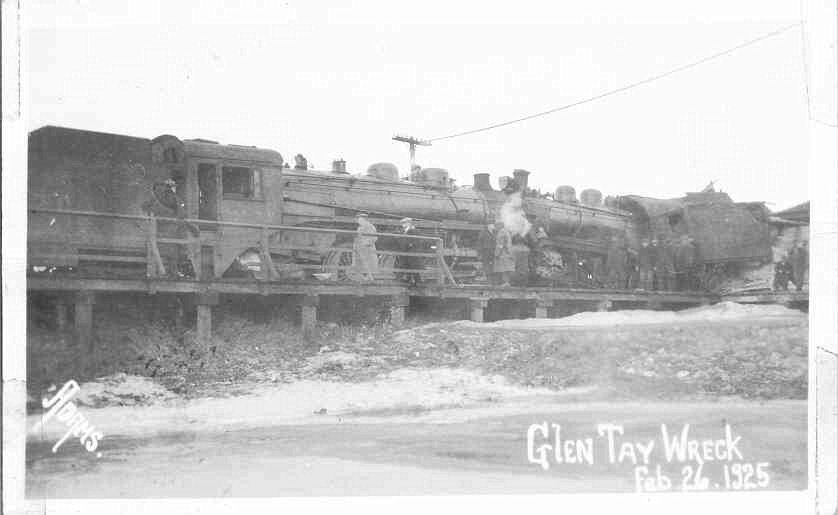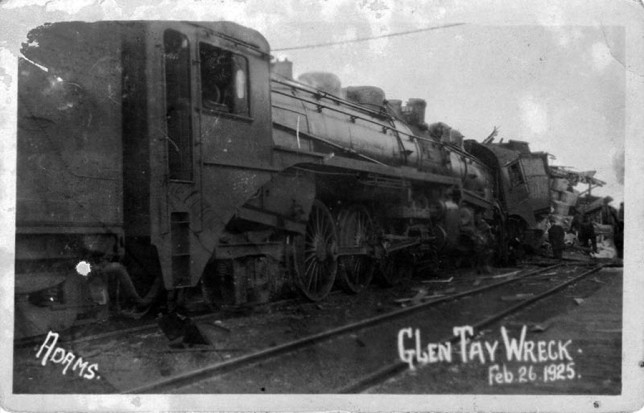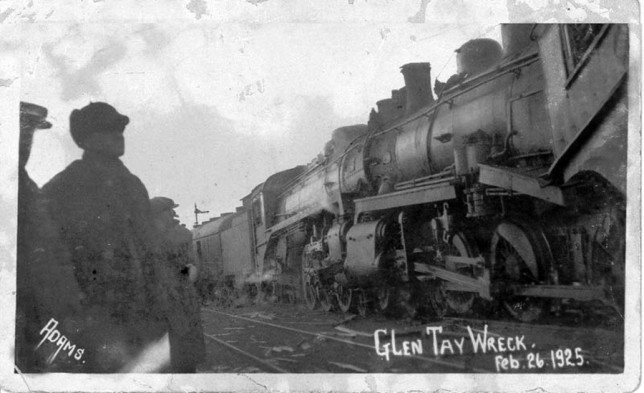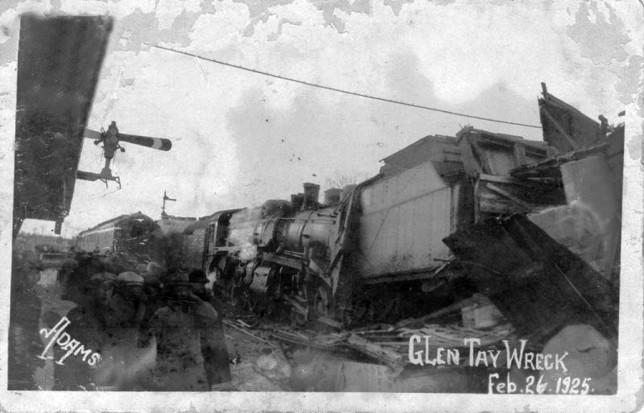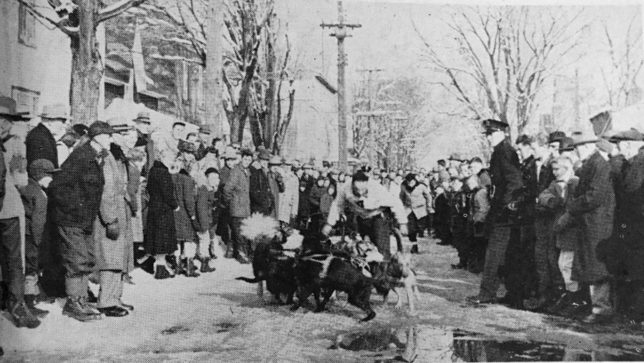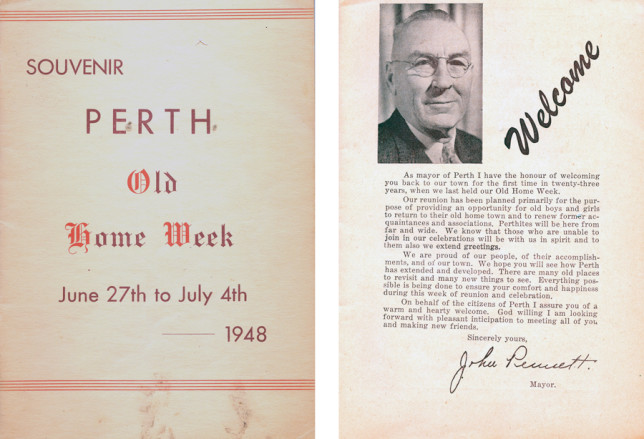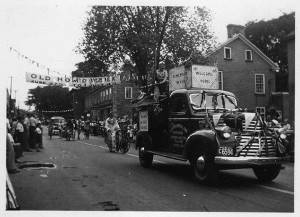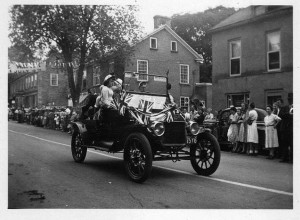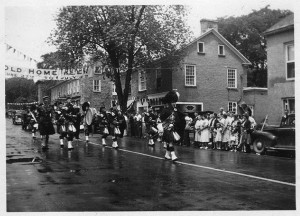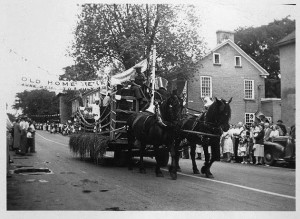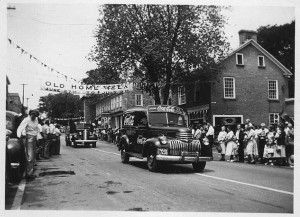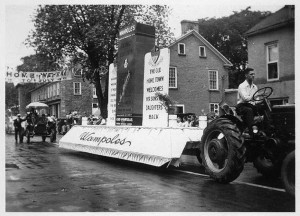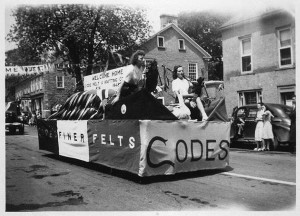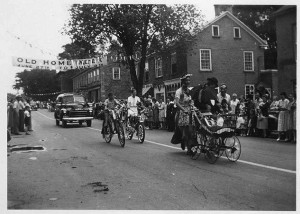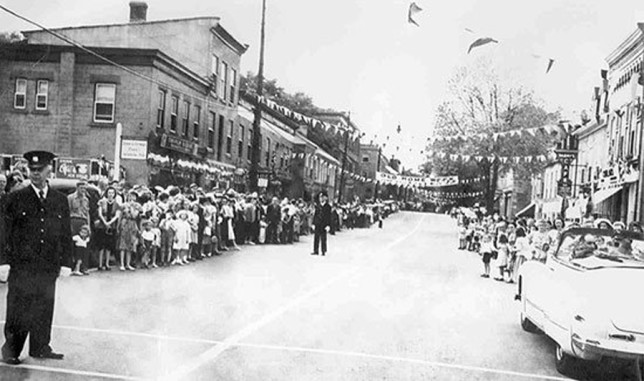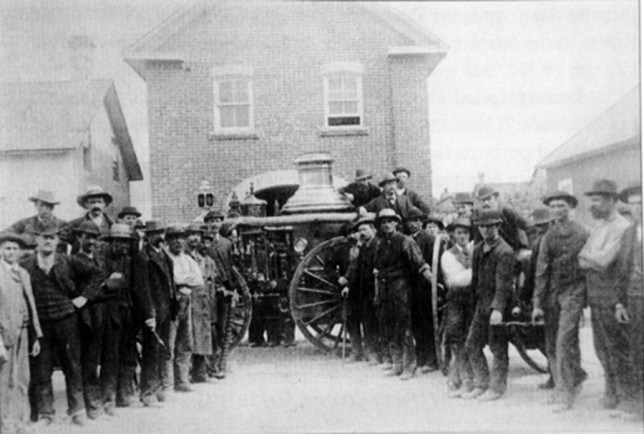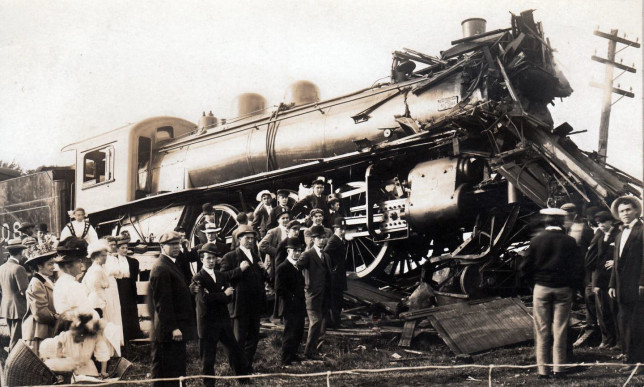THE LAST FATAL DUEL – 1833
In the Old Burying Ground, used by Presbyterians, Anglicans and Roman Catholics a-like from 1821-1868, is still to be seen the gravestone of Robert Lyon who, as the inscription states “fell in mortal combat” on June 13, 1833. The duel in which Lyon died was fought outside of the tow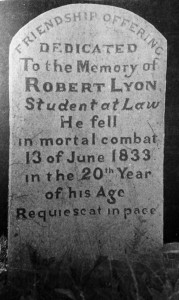 n limits on the bank of the Tay River on William McLaren’s farm. The duelists were law students, Lyon, who was articled to a relative, Thomas D. Radenhurst and John Wilson, who articled to James Boulton. Initiated by the 20-year old Lyon at the urging of his eventual “second” Henri Lelievre, the dispute centred about a Miss Elizabeth Hughes, a local schoolteacher and governess in th Boulton home and a former student of Wilson’s. This excerpt from “The Pioneer Pastor” describes as follows, ” John Wilson and Robert Lyon, two law students, quarrelled about a young lady and fought the last duel in Upper Canada. This was in June, 1833, a year before John Cameron founded the good old “Bathurst Courier,”. Wilson sent the challenge, because Lyon slapped his face in the court house. At the second fire Lyon, who is said to have directed his second to load his pistol with peas, fell dead before assistance could reach him, pierced through the heart. The dreadful tragedy occurred on the right bank of the Tay, causing great excitement. Wilson hid a few days, then surrendered to the authorities, was tried and acquitted.” An old newspaper account also describes the duel in these words: Mr. Lyon was what is called a crack shot, but both missed at the first fire. Efforts were made … to bring about an understanding, but both gentlemen were proud, and Mr. Lelievre, it is said, would not agree to an amicable settlement, and the pistols were reloaded and the principals were again placed on the ground. At a word both pistols exploded together and Mr. Lyon fell heavily backward, shot through the heart. The ball entered below the levelled right arm and he was mortally wounded. This was the last duel in Ontario. It served to extinguish forever the few embers of the old duelling spirit.
n limits on the bank of the Tay River on William McLaren’s farm. The duelists were law students, Lyon, who was articled to a relative, Thomas D. Radenhurst and John Wilson, who articled to James Boulton. Initiated by the 20-year old Lyon at the urging of his eventual “second” Henri Lelievre, the dispute centred about a Miss Elizabeth Hughes, a local schoolteacher and governess in th Boulton home and a former student of Wilson’s. This excerpt from “The Pioneer Pastor” describes as follows, ” John Wilson and Robert Lyon, two law students, quarrelled about a young lady and fought the last duel in Upper Canada. This was in June, 1833, a year before John Cameron founded the good old “Bathurst Courier,”. Wilson sent the challenge, because Lyon slapped his face in the court house. At the second fire Lyon, who is said to have directed his second to load his pistol with peas, fell dead before assistance could reach him, pierced through the heart. The dreadful tragedy occurred on the right bank of the Tay, causing great excitement. Wilson hid a few days, then surrendered to the authorities, was tried and acquitted.” An old newspaper account also describes the duel in these words: Mr. Lyon was what is called a crack shot, but both missed at the first fire. Efforts were made … to bring about an understanding, but both gentlemen were proud, and Mr. Lelievre, it is said, would not agree to an amicable settlement, and the pistols were reloaded and the principals were again placed on the ground. At a word both pistols exploded together and Mr. Lyon fell heavily backward, shot through the heart. The ball entered below the levelled right arm and he was mortally wounded. This was the last duel in Ontario. It served to extinguish forever the few embers of the old duelling spirit.
After Lyon fell, mortally wounded, he was transported back to the foyer at Inge Va (66 Craig Street), where he succumbed to his wounds. After Lyon’s death, Lyon’s second, Henri Lelievre, fled the country fearing that some also considered him responsible for the duel, since he had encouraged a second round after both had missed their first shot. He is believed to have died in Australia. Wilson and his second Samuel Robertson were both charged with murder in Brockville, Ontario, though acquitted. Also from the Pioneer Pastor, “Wilson moved westward, rose to eminence at the law, was appointed to the bench, and ultimately became Chief Justice of Ontario. During his protracted judicial career he would never sentence a man to death, leaving the task to his colleagues. He bitterly mourned his participation in the duel on each anniversary of which he would shut himself in his room to fast and pray and give vent to his sorrow.” Two years later after the duel Wilson Married Elizabeth Hughes and they had three children together. Wilson went on to become a judge and Member of Parliament before dying in 1869. The pistols can be seen on display in the Perth Museum.
For more information:
Here is a link to the story Field of Blood – Locating the Site of the Last Fatal Duel by Ron Shaw
http://www.perthhs.org/documents/last-duel-location-shaw.pdf
Lanark County Genealogical Society – The Duel of 1833
Lanark County Genealogical Society – The Wilson-Lyon Duel
BOOKS
Author David Mulholland claims to have uncovered a manuscript written by an obsessive blacksmith who sheds new light on events that led to the fatal duel between law students Robert Lyon and John Wilson on June 13, 1833, in Perth, Upper Canada. But is the blacksmith’s passionate and dramatic narrative fact or fiction? You, the reader, will have to decide.
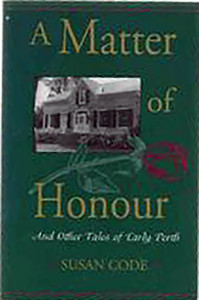 A MATTER OF HONOUR AND OTHER TALES OF PERTH
A MATTER OF HONOUR AND OTHER TALES OF PERTH
Susan Code
General Store Publishing House, 1996 • ISBN 1-896182-27-5
DOMINION DAY 1867
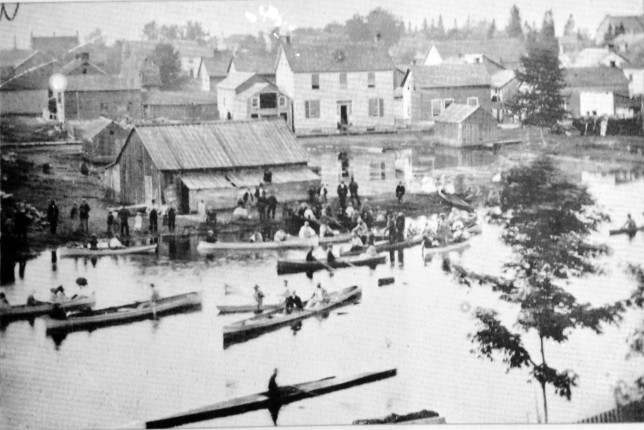
The first Dominion Day Celebration held in Perth, 1867, the year of Confederation. The photo shows the Basin and Tay River at that time. Photo courtesy The Perth Museum.
The following is an account of the celebrations in Perth on that historic day celebrating the beginning of a new country from the Perth Courier a few days after July 1st, 1867:
DOMINION DAY
Procession – Address – Regatta – Fireworks
At the early hour of five o’clock on Monday morning, the successive discharges of two cannon captured from the Americans during the 1812-15 war, proclaimed to the suddenly aroused denizens of our good old town (Perth), that the Natal Day of the “New Nationality” had arrived, and was to be celebrated in a manner worthy of the union of four such important Provinces as the two Canadas (Upper and Lower), New Brunswick and Nova Scotia. The morning was clear and calm, with not a cloud to darken the horizon; and if being favoured with sunshiny weather for inauguration may be taken as a favourable omen of its future prosperity, then the Dominion of Canada will be signally blessed in the career so auspiciously begun on the memorable First of July, 1867.
THE FIREMEN
The Fountain and Union Fire Companies turned out soon after 9 o’clock and headed by St. Patrick’s Brass Band, proceeded to test the Engines, the former at the tank on Wilson Street, the latter at Mair’s corner.
THE PROCESSION
A reasonable time having elapsed after the above occurrence, a procession consisting of the Band, the Volunteers, the Firemen, the Corporation, the resident Senator and the Parliamentary Representative, the Judge, the Sheriff, the Professional Gentlemen, the Grammar School Teacher, together with a large number of the most prominent citizens and various leading farmers from the surrounding Townships, formed at the Market Square and marched along Gore, Foster and Drummond Streets to the field immediately opposite Judge Malloch’s residence. This procession was one of the most imposing features of the day.
THE PROCLAMATiON
No sooner had the procession become properly disposed on the field, than the Mayor mounted the nostrum, which in this instance chanced to be a cannon, and with a voice of awful majesty announced the order of the proceedings. His Woship then read the Queen’s Proclamation, which impressive ceremony having been duly concluded, loud cheers were given for “Our Gracious Sovereign” and “ The New Dominion,” and Alex Morris, Esqu., M.P.P. for south Lanark, ascended the eminence just vacated by the Mayor an proceeded to deliver an address.
ROYAL SALUTE
The more intellectual part of the proceeding over, the Volunteers and Cannoiers fired a Royal Salute. Some evolution were likewise performed by the Volunteers, whose manly bearing and soldierly appearance elicited numerous plaudits from the spectators.
THE REGATTA
Returning from the scene of so many attractions, the crowd patiently awaited the Regatta. For some time a disappointment appeared inevitable, owing to the multitude of logs in the river; however, this difficulty was at length overcome, and the sport commenced in good earnest. Several boats competed for the Prizes; and though not at all up to general anticipation, the Regatta passed off pretty fairly. A couple of laughable mishaps in the shape of “dunkings”, caused no little merriment at the expense of the aquatic disciples of Neptune. One individual fell from the Bridge plump into the stream, whence he dexterously contrived to emerge in an exceedingly wet state, and minus his watch and some other paraphernalia. A boat containing two young men was capsized and its occupants ignominiously “spilled” into the meandering Tay, greatly to the delight of the sundry juveniles, as well as “children of a larger growth”.
FOOT RACE
In the afternoon, Mr. John Lee, the Perth champion, and a miner from Burgess, who has lately arrived from England, and is said to be a regular professional, ran a Foot Race on Herriott street. This race attracted great attention, and was watched with eager interest. Upon Lee being declared the winner, the applause for a few moments knew no bounds; his friends throughing to grasp him by the hand and congratulate him on his victory.
A NEW BUT GOOD IDEA
Not the least attractive feature of the day was the original idea of Messrs. McCarthy and Moffat, in dressing up their locomotive – the “Tay” – in a very fancy and tasty design. On the front there were place two large evergreen trees, interlaced with silk ribbons, in red, white and blue; siz flags of various design were also displayed on different parts of the engine, together with other suitable paraphernalia. Altogether
The staunch enging, “The Tay.” did her part well in the celebration of the day, and great praise is due to Messrs. McCarthy and Moffat for the trouble and expense to which they went in their successful endeavors to assist in the festivities of the occasion.
FIREWORKS
An excellent assortment had been procured from Boston and soon after 9 o’clock the discharge of a rocket ushered in the pyrotechnic display. Showers of rockets, stars etc. with now and again a revolving wheel by way of variety followed each other in rapid succession, and presented a gleaming spectacle attractive to the beholders. A large number of boats, illuminated with Chinese Lanterns and bearing tasteful transparencies as the Beaver and Maple Leaf, the Prince of Wales’ motto, “Canada Floreat,”etc. glided smoothly over the glassy surface of the sparkling waters and with the strains of the Brass Band, wafted by the evening breeze, completed a panoramic scene on which the eye loved to linger. The display continued till 11:30 o’clock, and well pleased with everything in general and themselves in particular, the assembled hundreds dispersed, having, as in duty bound, first listened to the inspiring anthem so dear to every true Canadian. “GOD SAVE THE QUEEN”.
CONCLUSION
We may state, in conclusion, that to Messrs. Kippen, Doran and Malloch, are due the credit for getting the fine display of fireworks exhibited – – the like of which we venture to say was not excelled in Canada, for variety, beauty of design and general splendor.
GOLDEN JUBILEE 1887
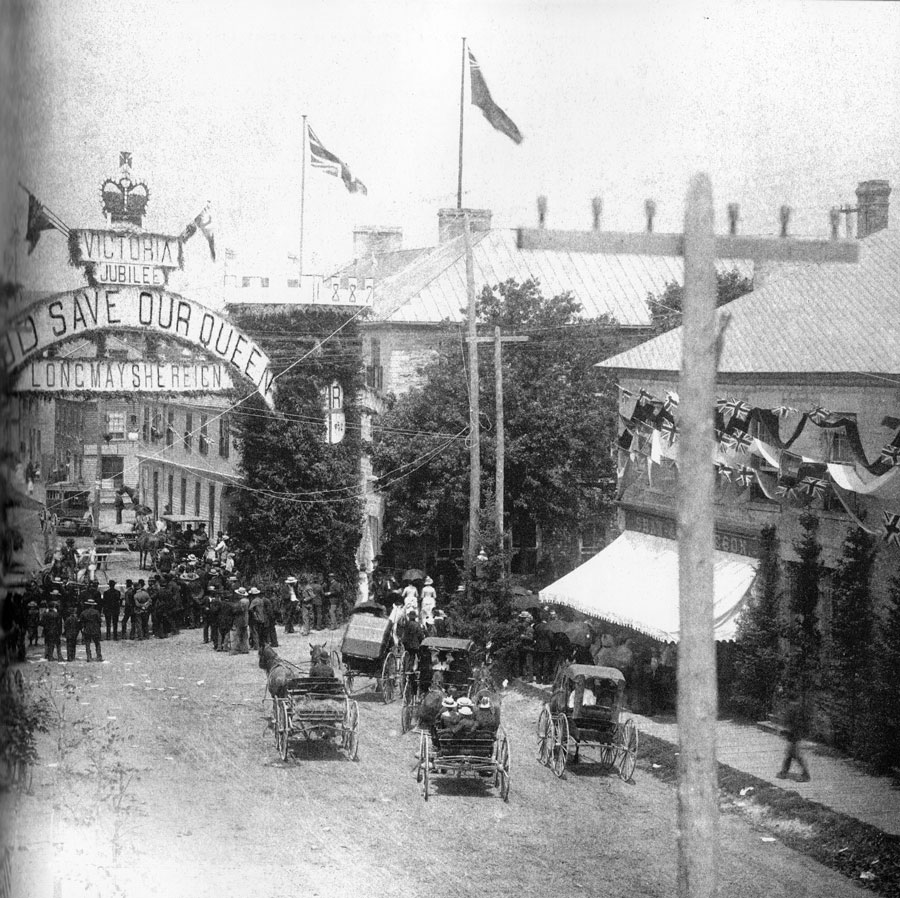
Perth as did many communities which were in the Commonwealth, celebrated Queen Victoria’s Diamond Jubilee in 1887. The photograph shows the corner of Gore and Foster streets. The store with the awning was Shaw & Matheson. Note the bunting on the Shaw building and the large arch suspended over Gore Street at the Hotel Perth. Photo courtesy The Perth Museum.
PERTH COURIER, FRIDAY JULY 8, 1887
QUEEN’S JUBILEE CELEBRATION – The First of July in Perth.
Those who rose from their beds at peep-o’-day on Friday morning to see after the weather noticed that the sun was shining brightly, and gave every evidence of developing fine weather all day for the jubilee celebration. Those who were not quite so early in their weather studies were roused about six o’clock by a sudden clangor of bells – a chorus of continuous alarms, or tolling or jangling from every tower in town. There was every sort of bell music, from the solemn booming of the old patriarch in the Catholic Church tower to the lively outcry of the youthful West Ward fire alarm, with the steady tones of the town clock and the noise of half a dozen other rivals sandwiched in between. This was the first diversion of the day, and fittingly ushered in the demonstration for which the people of Perth been for some time preparing to honour Her Majesty’s jubilee coronation year.
THE DECORATIONS
While the crowd from all points of the compass are pouring into town to participate in the festivities, we will take a look at the appearance of the old town in its jubilee attire. On Gore Street three evergreen arches high and broad break the vista like so many ivy grown viaducts or ruined castles, only the streaming flags in brilliant red, white and blue, and the gay tinted buntings and other decorations give life and freshness to each one. The arch, erected at the corner of Gore and Craig Streets, East Ward, may be called the Firemen’s special arch, for under here their road race took place, and the arch was festooned with their hose. The next one, built at the Town Hall, almost similar in appearance, might be called the Volunteers’ arch, as its centre decoration consisted of a radiation of bayonets. Here too were handsome and appropriate mottoes, and attended by a brilliant retinue of all kinds of flags and banners to be found in the British service. We now come to the third one on this street – that stretching diagonally across Gore and Foster Streets – from the Hicks’ House to Warren & Mcarthy’s hardware store. This is the grandest and most majestic of the arch family. Rising to a height of over fifty feet, it covers a length of ground measuring ninety-two feet, divided into one main and two lesser arches. There is a profusion of loyal mottoes and the usual decorations all over this arch, and its whole appearance is grand and beautiful. This was built by private parties, the principal among whom were Messrs. Wilson, Warren & McCarthy, A. Meighen & Bros., and Shaw & Matheson. This arch was capped by a huge crown of the pattern supposed to be worn by British sovereigns in good standing. The last arch stood at Barrie’s Hotel, across Wison Street and like the first two was constructed by the firemen. The side towers were pierced with narrow windows, after the style of the castle architecture and at night lights were put in these which showed with fine effect. This arch was crowned by a large figure of a Canadian beaver and the whole arrangement was striking and pleasant to the eye. In fact, these four arches gave the street decorations an air of completeness and massiveness generally only to be seen in cities.
All over town gay flags, banners and streamers were flying against the blue dome of the sky and stores and private houses were decorated with evergreens, red, white and blue festoons, arches, miniature flags, etc., while on every hand Chinese lanterns hung suspended, ready for the illuminations in the evening. Among the handsomest day decorations were those on the store of Messrs. Shaw & Matheson. These consisted of three lines of red, white and blue draperies hung around the two street sides of their store, the effect being rich and most attractive. A handsome side arch of evergreens and flags from the windows of every story made the store of Messrs. A. Meighen & Bros. very conspicuous. On both sides of Foster Street the stores were rich with displays of bunting and evergreens, and down Gore Street the same taste had been displayed. Warren & MacCarthy’s W. Ferrier’s, McMaster & Co., G.E. Armstrong, J.F. Kellock, the residences of Sheriff Thomson and Mr. Thomas Brooke, the stores of Mr. A. Robertson and Mrs. McCormick showed evidence of taste in their decorations. A handsome arch projected over the sidewalk, from the main entrance of the Allan House.
GAMES AND SPORTS
The first attraction in the way of skill and muscle display was the hose-reel contest between the Tay Steamer and the Union Fire Companies of Perth and the Dreadnaught Fire Company of Lanark. The Steamer Company won first place, making splendid time – only four seconds below the best American time on record.
THE PROCESSION
The biggest moving attraction of the day was the Trades Procession, which started about eleven o’clock paraded, with the various fire brigades and two brass bands, around the principal streets until noon. This show was simply immense and took by storm the whole list of spectators – old and young – men, women and children. Such an affair was unique and novel in Perth, and the whole thing was well done. The list of those who participated in the parade was something as follows: Perth Town Council, Tay Steamer engine, Lanark Brass Band. Stanley’s Carriage Works, represented by a $350, two-seated, extension Top carriage, the best ever made in Perth. Perth Furniture, D. Hogg, proprietor. Large double canopy wagon neatly decorated with bunting, containing parlor furniture, writing desks, etc. Employees engaged in upholstering and finishing. Thorton’s Piano and Sewing Machine Agency. West End Harness Shop, William Farrell, proprietor. A tastefully decorated rig containing harnesses of every description, rugs, whips, etc. McArthur’s Tinshop, Coal cart; a large house covered with galvanized iron with string band in front and tinshop in rear. Ferrier’s Harness Shop – This was well represented with top wagon drawn tandem, hung round inside with harness of every description, whips, rugs, combs, brushes, etc. On top and suspended on a cross bar was an immense collar measuring 6 feet in length, beautifully finished. The trunk line was represented by a mammoth trunk built for the occasion and drawn by his St. Bernard dog “Max”. Smith Fall’s Brass Band. W.G. Bates with racer from Olivers Stock Farm. East Ward Meat Market – J. Noonan, Proprietor, large wagon, frame around, and nicely decorated, divided into two compartments, the front part containing live white steer and the other part being hung round with beef, mutton, lamb and veal ready for the market. McLenaghan, Agricultural Implement Agent, binders, mower, reaper, hay tedder on farmer’s wagons. A good display all. West Ward Meat Market, G. Finlay, Porprietor, delivery cart; large wagon with extended platform, open sides, canvas cover, drawn tandem, containing a full display of dressed meat of all kinds carefully covered from dust, and employees looking clean and cool. Perth Expositor, with unrecognizable driver; platform wagons, containing case with boy engaged in type-setting and a small Gordon Job Press on which was run off upwards of 1,000 programmes for the day during the procession, with various other items belonging to the printing office. Allan House Bus, with “Uncle Tom” on top as runner for the house. Thomas Smith, Mason, with house in course of erection. Lillie’s Foundry and Bolt & Nut Works. D. McDonald, cutting stone. Warren & McCarthy, Hardware Merchant’s, a 13ft. by 18ft. platform on wagon, with red and white canvass top, and 6 feet border round bottom, containing six coloured musicians and a large display of hardware, two gold and green banners hung on sides of wagon, driver in full livery. Centre Ward Meat Market, G.F. Barrie, proprietor, 4 rigs first the large gathering wagon, containing live stock, second a rig representing a slaughter house with men dressing meat, third a meat market wagon, large platform containing block and instruments for the cutting up of the various portions of beef, mutton, lamb, veal etc. which hung round the inside of the rig – all dressed and looking nice. Lastly the delivery cart – all four decorated with evergreens and bunting. B.H. Wright & Co. Tailoring Establishment – Spring wagon with peaked evergreen top – employees at work cutting and making suits. Johnson’s Ginger Ale Works, Archie Johnson, proprietor – open bus with string band, then large wagon with compete machinery for the manufacture of Ginger Ale, at which men were employed along the route in bottling and giving it out to various thirsty ones along the route. Followed by his delivery rig – all four fitted up in good shape. Perth Marble Works, J. Dolan, proprietor – Tombstones imported from the best Vermont quarries in various stages of completion, with workmen employed on them. Thomas Allan, Lumberer with load of first class stuff. The Singer Manufacturing company’s business in Perth was well reprented by a display of its five wagons all of which work from the branch office here. They were tastefully decorated with evergreens and flags. Streamers printed on canvas strung from the tops of trees fastened to the front and back of each wagon, gave an idea of the extent and importance of this largest of sewing machine companies, as well as telling of the well know durability of their machines.
In the afternoon, an adjournment was made to the agricultural grounds, when a crowd of some 3,000 people gathered to witness the games and sports of an athletic character. The Lanark and Smith’s Falls brass bands were in the field, and furnished martial music for the assembled thousands there. The attractions here were very enlivening and kept the throng full of interest in the blazing hot sun until late in the afternoon. Mr. J.A. Laurie had a booth on the rounds for the sale of ice cream, summer beverages and luncheon and did an immense business. The livery men also did a wonderful afternoon’s trade in conveying people to and from the grounds.
ILLUMINATION AND FIREWORKS
The beauty, loveliness and attractiveness of the town were even increased after sunset. Crowds of people in their holiday clothes thronged the streets, while the darkness brought out in bold relief the lighted up arches, the gayly coloured Chinese lanterns gleaming all along Gore and Foster Streets and here and there among trees in gardens and festooned along the front of houses all over town. The display of Chinese lanterns in front of the residences of Mr. John Hart was a gem of illuminated decoration and was faultless in design and arrangement. The lanterns were hung in graceful festoons from trees to the house and were of every colour, size and pattern. Some of the larger ones showed admirably the peculiarities of Chinese ideas in regard to beauty of shape and pictorial art and were interesting from that view alone. This display must have been a costly one, but them Jubliees come only once in fifty years. The Bank of Montreal display was also one of the grand attractions of the evening. Beautiful Chinese lanterns similar to those in variety and design at Mr. Hart’s were suspended from each of the three stories of this fine building, and made a picture, whether seen from a distance or close by like those said to exist only in fairyland. Between nine and ten o’clock the committee of firemen, appointed for this purpose proceeded to set off the fireworks procured for this occasion. Some of the varieties were very beautiful especially that representing a c rown and the sky was made luminous with shooting rockets and roman candles, spinning wheels etc. The fireworks ended the day’s demonstrations. From early morning till ten the town had been a perfect hive of busy celebration and when the end came everyone was both satisfied with what had been experienced and glad it was all over and nobody hurt. The town never looked better than it did this day, and the citizens have good reason to be proud of the day’s demonstration and when it all was over there were no regrets anywhere.
JULY 12, 1890
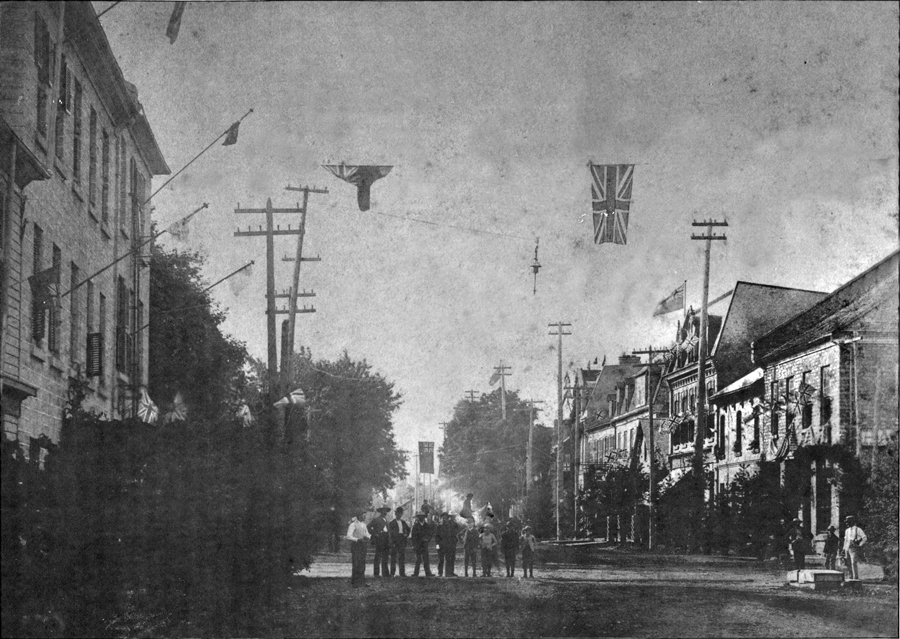
Orange Men’s Day celebrations at the intersection of Gore and Foster Streets. Note “King Billie” on white horse in centre of picture.
MAMMOTH CHEESE – 1893
Since 1864 when the first cheese factory in Canada was built cheese making in Canada has become an art. Canadian Cheddar cheese is now exported to almost every country in the world. The most famous Canadian cheese ever exported was the Mammoth Cheese from Perth Ontario, which was displayed at the Chicago’s World Fair in 1893 and won the Diploma and the Bronze Medal. The cheese, the largest ever made anywhere was a join venture of 12 Ontario cheese factories in and around Perth Ontario.
The names of the factories and the cheesemakers in charge were as follows: Cheese Factory: Riverside (Perth), Cheesemaker: Jas. McCann , Cheese Factory: Mississippi, Cheesemaker: Jas. Clark, Cheese Factory: Drummond Centre, Cheesemaker: Richard Halpenny Cheese Factory: Balderson’s Corners, Cheesemaker: Wallace Symes, Cheese Factory: Fallbrook, Cheesemaker: David Ennis, Cheese Factory: Harper’s Corners, Cheesemaker: W. Wrathall, Cheese Factory: Bathurst Mutual, Cheesemaker: Max. Gibson, Cheese Factory: Tay Banks, Cheesemaker: John McMunn, Cheese Factory: Scotch Line Union, Cheesemaker: John Wiltsie, Cheese Factory: Lone Star, Cheesemaker: James Kirkland, Cheese Factory: Stanleyville, Cheesemaker: Thos. Wright, Cheese Factory: Clear View, Cheesemaker: Elijah Hughes
The cheese consumed 307,300 pounds of milk equal to one day’s product from 10,000 cows, weighed 22,000 pounds. It took three days to collect enough curd to make and when completed it measured six feet high and 28 feet in circumference. It was kept in a railway freight shed and in November 1892, the Governor General, The Hon Baron Stanley came to town with the Minister of Agriculture and other dignitaries to inspect the cheese.
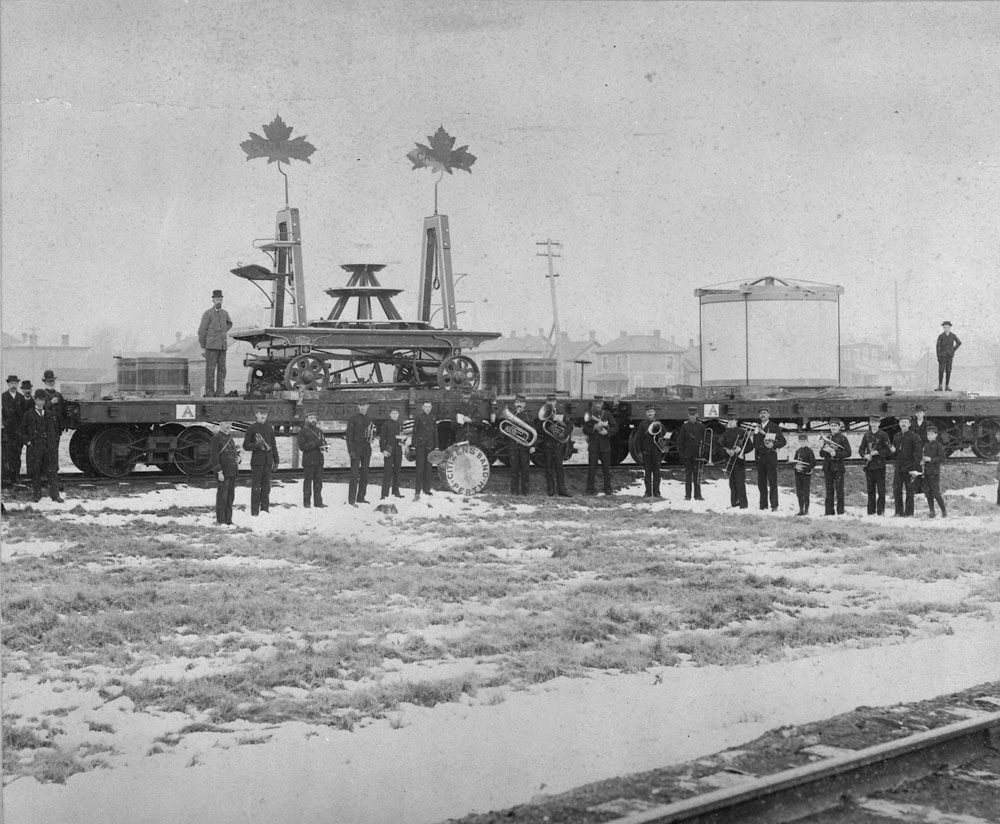
World’s largest cheese, 22,000 lbs., loaded on C.P.R. (Canadian Pacific Railway) flat cars in Perth, Ont., 1892. Photo Credit: Wilson-Croft / Library and Archives Canada / PA-091030
The Perth Courier, April 21, 1893 reported: Last Saturday the “Canadian mite” was taken from it’s winter quarters in the freight shed at the Perth Railway Station and placed on a flat car for shipment. The centre of the platform of the car settled some four inches under the great strain. All day Sunday the train was viewed by hundreds of people and early Monday morning the music of the Citizens Band intimated that the final farewell was to be given. Hundreds of people flocked to the station where men were found placing the decoration to give the train as attractive an appearance as possible. At seven o’clock the train steamed out amidst three hearty cheers from the crowd and “The Maple Leaf Forever” by the Band.
While the cheese was being installed for exhibit, it was reported in The Perth Courier, May 5, 1893, “that the mammoth cheese proved too heavy for the floor of the exhibition building and broke through it to the ground beneath. It was not injured, however, and was being replace on sounder underpinning”. The Mammoth Cheese was more talked about and written about than any other single exhibit at the fair”.
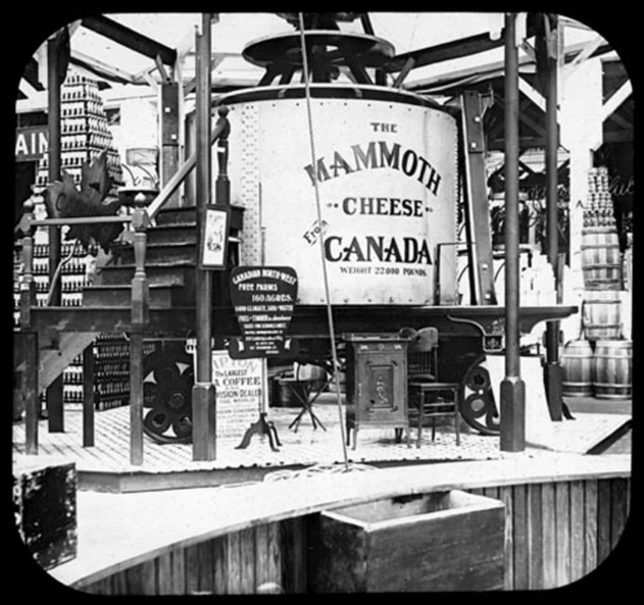
Display of the mammoth cheese from Perth, Ont. at the Chicago World’s Fair in 1893. C 286-3 Ontario Archives
Although it had endured six months under a glass roof in sweltering heat and considerable battering in its travels the cheese was bought by by Jubal Webb and sent to London, England in the spring of 1894. It was cut up with great ceremony and pronounce excellent in both quality and flavour. This cheese established a reputation for Canadian quality, a reputation which Canada’s cheese producers had diligently maintained.
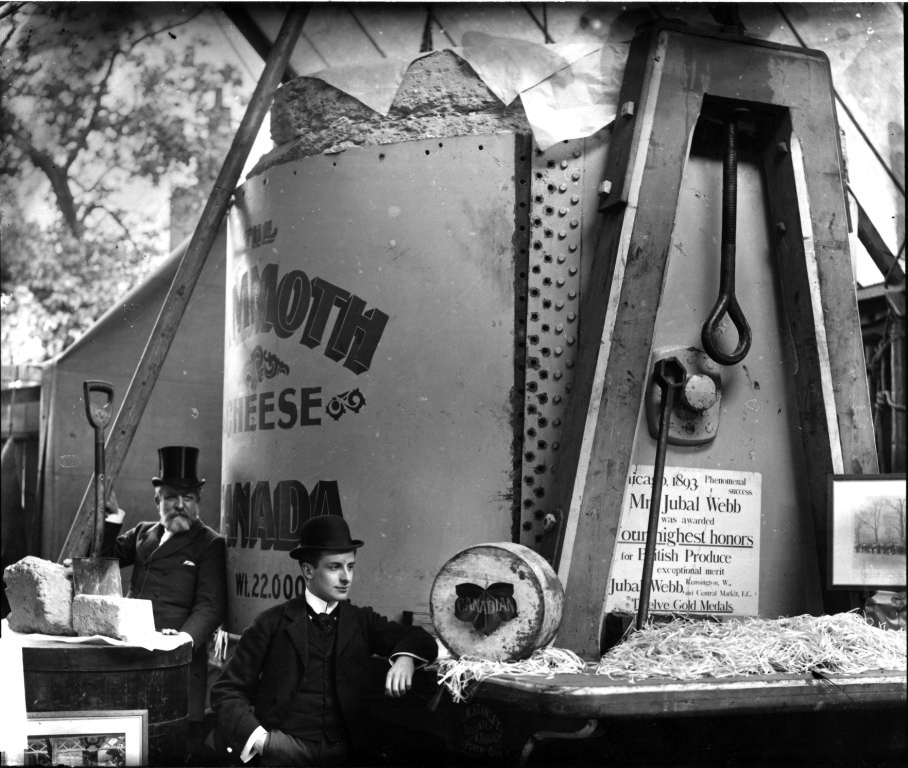
Mr Webb might be the gentleman with the beard superving the mammoth cheese from Canada so big you need to serve yourself with a shovel. Photo: RBKC Library
THE TAY CANAL
THE FIRST TAY CANAL
Proposals to make the Tay into a navigable waterway date to 1824, when local Perth entrepreneur William Morris started to lobby for this. When the construction of the Rideau Canal started in 1826, Perth business interests hoped that this would include the Tay, but the Superintending Engineer for the Rideau Canal, LT. COLONEL JOHN BY had no mandate to build any branch canals. When the Weatherhead family erected a mill dam across the Tay River in 1829, at the present day location of Port Elmsley, Perth business interests started to panic with the realization that they might lose the Tay as a navigable waterway. They started to float the idea of constructing a private canal linking Perth with the Rideau Canal. So it was decided to form a company to build the Tay Canal. On 16 March 1831, legislation to form the Tay Navigation Company was passed.
In 1831, JOHN JACKSON , an ex-Sergeant in the army and a miller in Perth was awarded the contract to build the canal. The route would lead from Perth to the mouth of the Tay River. The locks were to be smaller than those on the Rideau, only 27 by 6.1 m (89 by 20 ft), and a depth in the channel of 1.1 m (3 ft 7 in). This was a less expensive option and it was felt that it would accommodate most of the commercial traffic of the day. By the end of 1834, five locks, six dams (with timber slides), two swing bridges and several embankments were built. This became known as the First Tay Canal and was opened in 1834.
The First Tay Canal was never a commercial success. Revenues were not sufficient to allow proper maintenance and the condition of the canal deteriorated over the years. In 1865, several of the locks were destroyed by logs and the canal was shut down.
SECOND TAY CANAL
After the demise of the First Tay Canal, a political lobby started to build a new canal. The Canadian Government had taken over the Tay Navigation Company, and in 1881, they initiated an investigation into making the Tay navigable to Perth. Perth’s local member of parliament, John G. Haggart, had some influence in launching this investigation which was carried out by the engineers of the Rideau Canal under the direction of Superintendent Wise. Two routes were examined, one following the route of the First Tay Canal to Port Elmsley and a second involving a canal cut from Beveridge Bay of Lower Rideau Lake to the Tay River.
To the disappointment of the residents of Port Elmsley, the second route was chosen. In 1883, a Federal government order-in-council authorized a contract with A.H. Manning & Macdonald Company for the construction of the Tay Canal. The proposal included deepening the entire system to the required 1.7 m (5 ft 7 in) depth; cutting a 18 m (59 ft) wide, 2 km (1.2 mi) long canal to Beveridge Bay; building two locks near the south end of the canal cut, each with a lift of 4.0 m (13.1 ft); and building a flat overflow dam across the former channel of the Tay near the entrance to the new canal cut.
The locks were built to the same design and specifications as the Rideau Canal locks. Started in early 1885, they were completed in 1887. Final excavation of the canal to the required navigation depth and an expansion of the basin in Perth were not completed until 1891.
For a time, the canal from the Beveridges Locks to Perth became known as “Haggart’s Ditch”
Many steamboats plied upon the canal for the proposed use of merchants to run from Perth to Kingston and points in-between. With the C.P.R. opening of their car sheds and frequent train stops in Perth the demise of the the Tay Navigation Company was near.
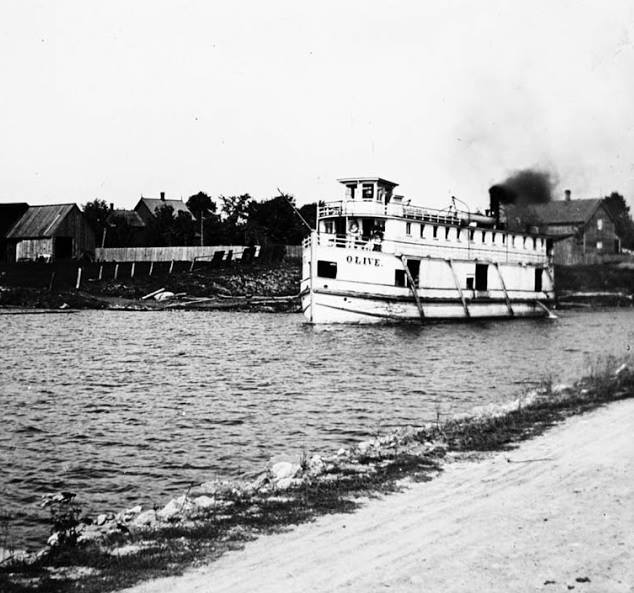
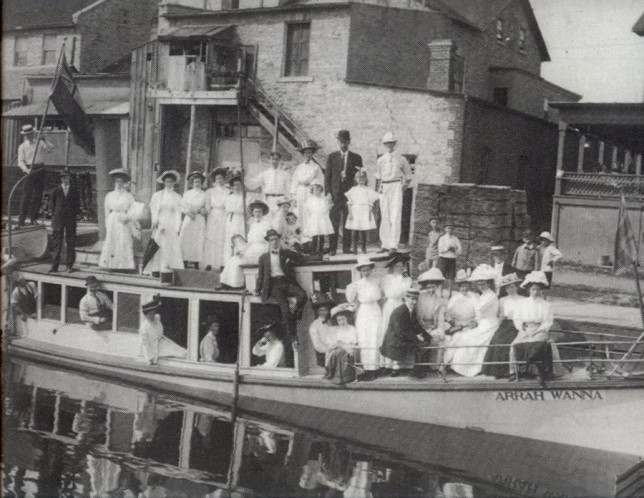
THE ARRAH WANNA 1909. First excursion of the Perth Vocal Society on the Arrah Wanna, on the west side of the Tay Basin, July 1st, 1909. Let to right: Walter Ferrier (water’s edge), Norman Dodds (sailor hat), Ethel and Eleanor Crosbie, Christy Wilson, Arthena Spalding, Edwin Wilson (killed overseas, 1916), Muriel and Dorothy Wilson with their father William J. Wilson, Professor Ainsworth (lower right, sailor hat), Ethel Gibson (sitting in front of Edwin Wilson), Mrs. W.J. Wilson (4th from right, sitting). In 1912 the Arrah Wanna was running special 3-day trips to Kingston. The boat left Perth at 7a.m. sharp, arrived in Kingston at 5p.m., spent the following day in Kingston and returned to Perth on the third day. Return fare for the round trip was $2.00. Photo and story: Perth Courier
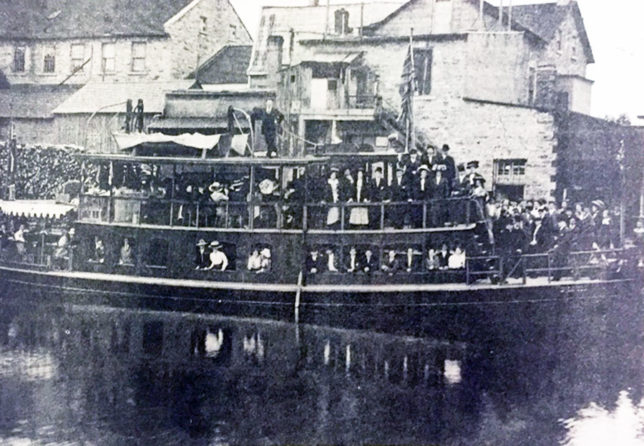
In 1896, the steam yacht St. Louis made its maiden voyage into Mathew’s Wharf then proceeded on the Butternut Bay route. She was owned by Peter Cavanagh of Perth, was 65 feet long with a 14’4″ beam and four foot draught. The cabins were 14 feet square and the craft could carry 130 passengers. She was sold in 1919 to a company in northern Quebec and operated on the Harracanau River from Amos to the fold mines located 50 miles south of the town.
For more detailed information:
Paddle Down the Tay by Susan Code:
http://www.urbanmarket.com/all-about-perth/taycanal.html
http://globalgenealogy.com/LCGS/articles/A-TAY.HTM
http://www.tayriver.org/tay175/documents/surveyors_report-1828.htm
http://www.perthhs.org/documents/TheFirstTayCanal.pdf
QUEEN VICTORIA’S DEATH 1901
1905 OLD BOYS REUNION-OLD HOME WEEK
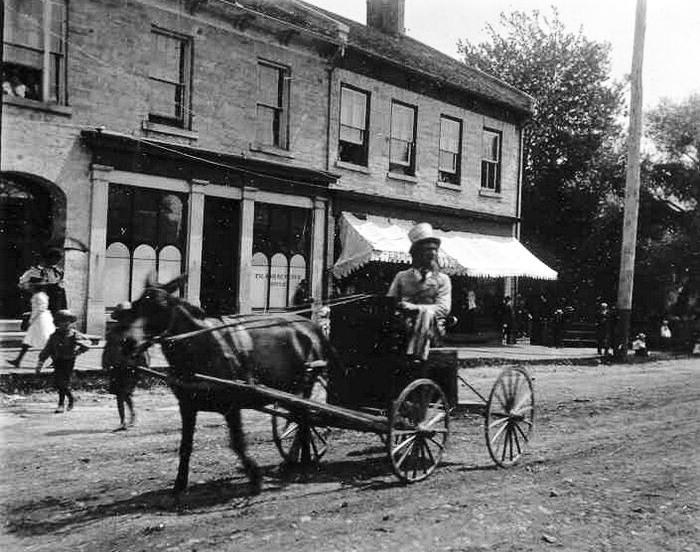
On Gore Street in front of the Brookes Block. To the far right is the bridge over the Little Tay with the Sheriff’s House behind the trees. Photo courtesy The Perth Museum
SPANISH INFLUENZA 1918
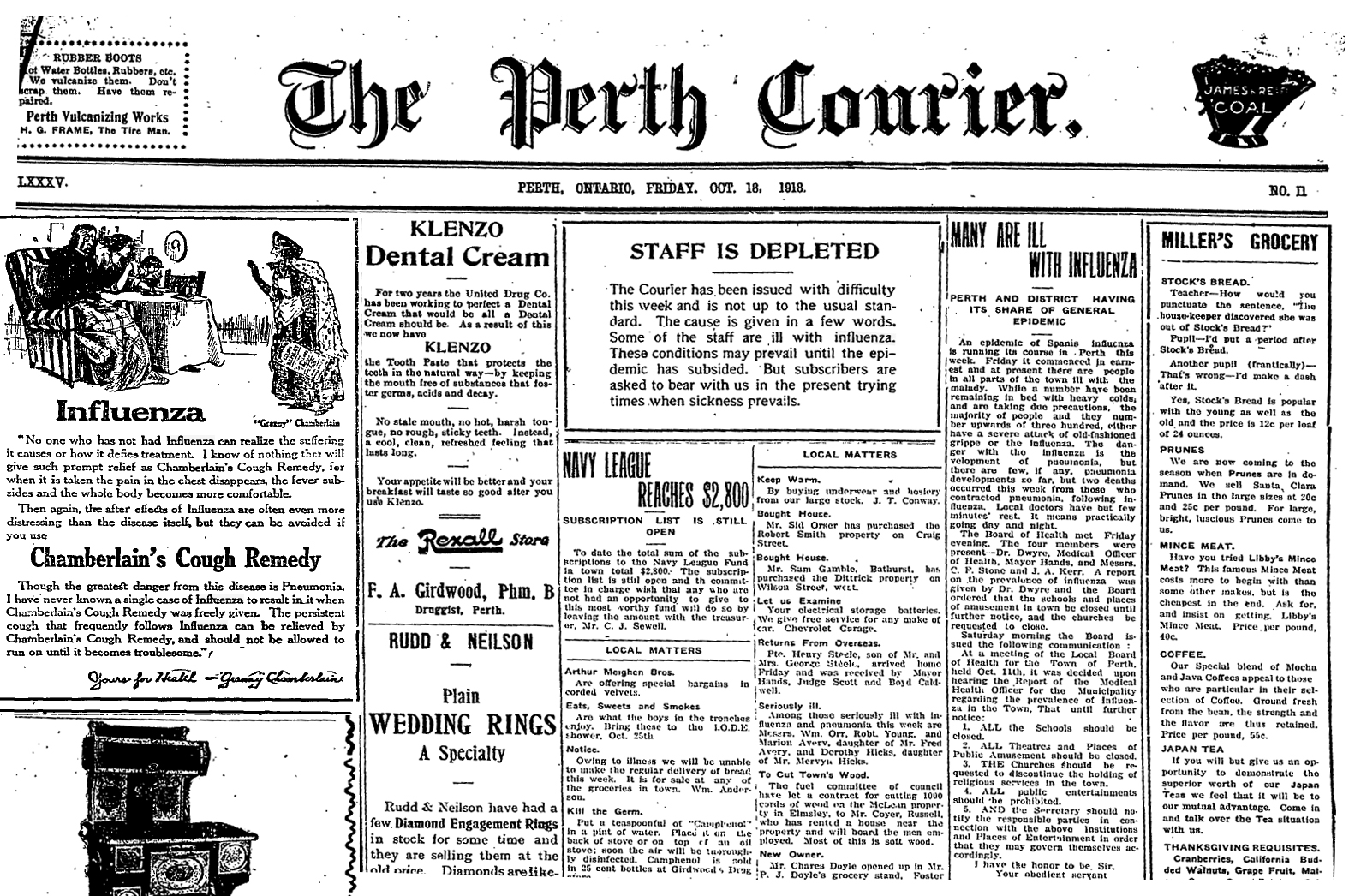
Perth Courier, Friday October 18, 1918
MANY ARE ILL WITH INFLUENZA
Perth and District having its share of general epidemic
An epidemic of Spanish influenza is running its course in Perth this week. Friday it commenced in earnest and at present there are people in all parts of the town ill with the malady. While a number have been remaining in bed with heavy colds and are taking due precautions, the majority of people and they number upwards of three hundred, either have a severe attack of old-fashioned grippe or the influenza. The danger with the influenza is the development of pneumonia, but there are few, if any, pneumonia developments so far, but two deaths occurred this week from those who contracted pneumonia following influenza. Local doctors have but few minutes rest. It means practically going day and night.
The Board of Health met Friday evening. The four members were present – Dr. Dwyre, Medial Officers of Health, Mayor Hands, and Messrs. C. F. Stone and J. A. Kerr. A report on the prevalence of influenza was given by Dr. Dwyre and the Board ordered that the schools and places of amusement in town be closed until further notice, and the churches be requested to close.
Saturday morning the Board issued the following communication: At a meeting of the Local Board of Health for the Town of Perth, held Oct. 11th, it was decided upon hearing the Report of the Medical Health Officer for the Municipality regarding the prevalence of influenza in the Town, that until further notice: 1. ALL the Schools should be closed. 2. ALL Theatres and Places of Public Amusement should be closed. 3. THE Churches should be requested to discontinue the holding of religious services in the town. 4. ALL public entertainments should be prohibited. 5AND the Secretary should notify the responsible parties in connection with the above institutions and Places of Entertainment in order that they may govern themselves accordingly.
I have the honor to be Sir, Your obedient servant, JOHN A. KERR, Secretary Local Board of Health.
Knox, St. Andrew’s, Asbury and the Baptist church complied with the request and no services were held Sunday, nor Sunday School. And mid-week meetings have not been held and will not be until after the epidemic subsides. St. James Church held 8 o’clock celebration of Holy Communion and the regular morning. St. Johns church just a short service was held in the morning.
The schools have all remained closed this week and the Balderson theatre closed Friday evening and will remain closed until new orders are issued. On Tuesday the Board of Health decided to prepare the Haggart home to accommodate a number of cases and the local branch of the St. John Ambulance Brigade is attending to the nursing requirements of several patients who have been taken there. Miss Elsie Walker of town is in charge. An appeal is made for supplies for the home.
And Perth is not alone seized with the influenza. Throughout the townships there is much sickness and a number of schools have been closed while those open have few pupils in attendance. Lanark, Carleton Place and Smiths Falls are all in the throes of the epidemic. At Lanark in each house where a case has developed the others of the family have been asked to remain at the house and not mingle with other people. Food and all requirements are supplied them by the policeman. This is an effective means of quelling the spread of the epidemic and might be adopted with profit by other places.
In Perth three business places are closed this week on account of employers and emplyees being ill and the factories are all running short handed.
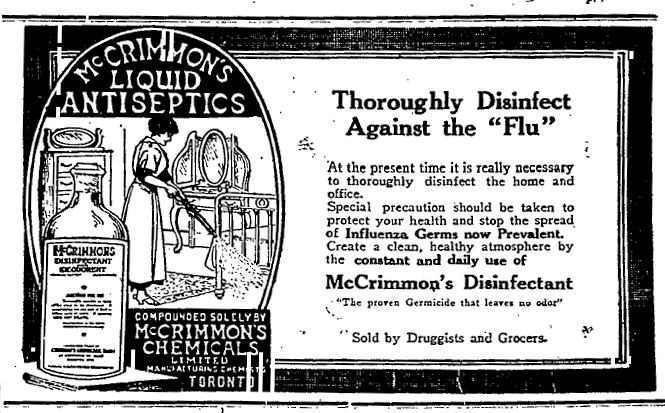
OLD HOME WEEK 1925
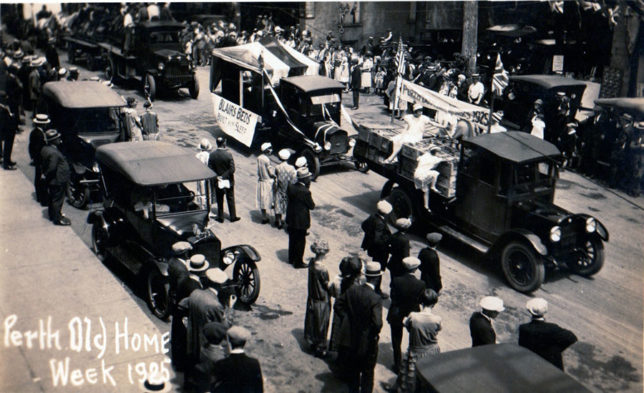
Parade shown at the corner of Herriott and Gore Streets in front of Conways. Looks like the girls sitting on the soda cases from the Perth Bottling Works may be handing out free pop. Second vehicle is from Blairs Furniture Store advertising Blairs Beds Built for Sleep. Post card courtesy The Perth Museum.
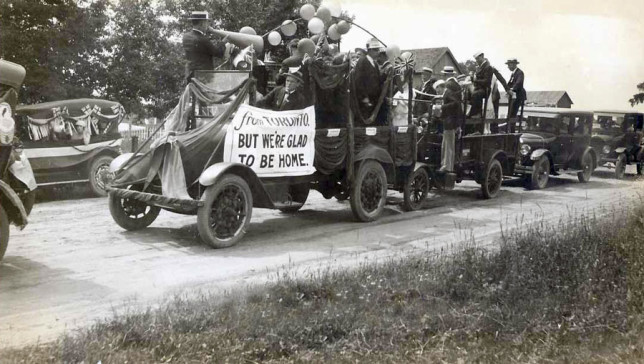
W.L. McKinnon with the megaphone and Jean McKinnon driving Model T Ford. Photo courtesy Peter Higgins.
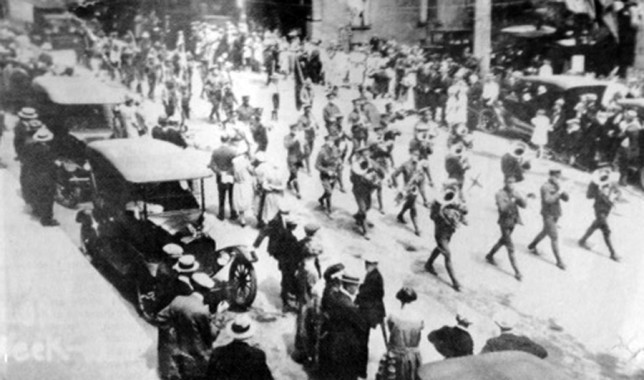
42 Regiment Band (Perth Band) at the Old Home Week in 1925. Members of the band: Coronets: Vic Ottman, Alf Keays, Caleb Srong, Deb Oakes, John Enright. Clarinet; A.V. McLean. Saophones: Miller Cameron, Bert Young, Ernie O’Heare, Hal Burns. Trombones; Norman Lessard, Al Vallely. Horn; Bill Brumby. Bass; George Saunders, Bill Wright. Drums: Eli White.
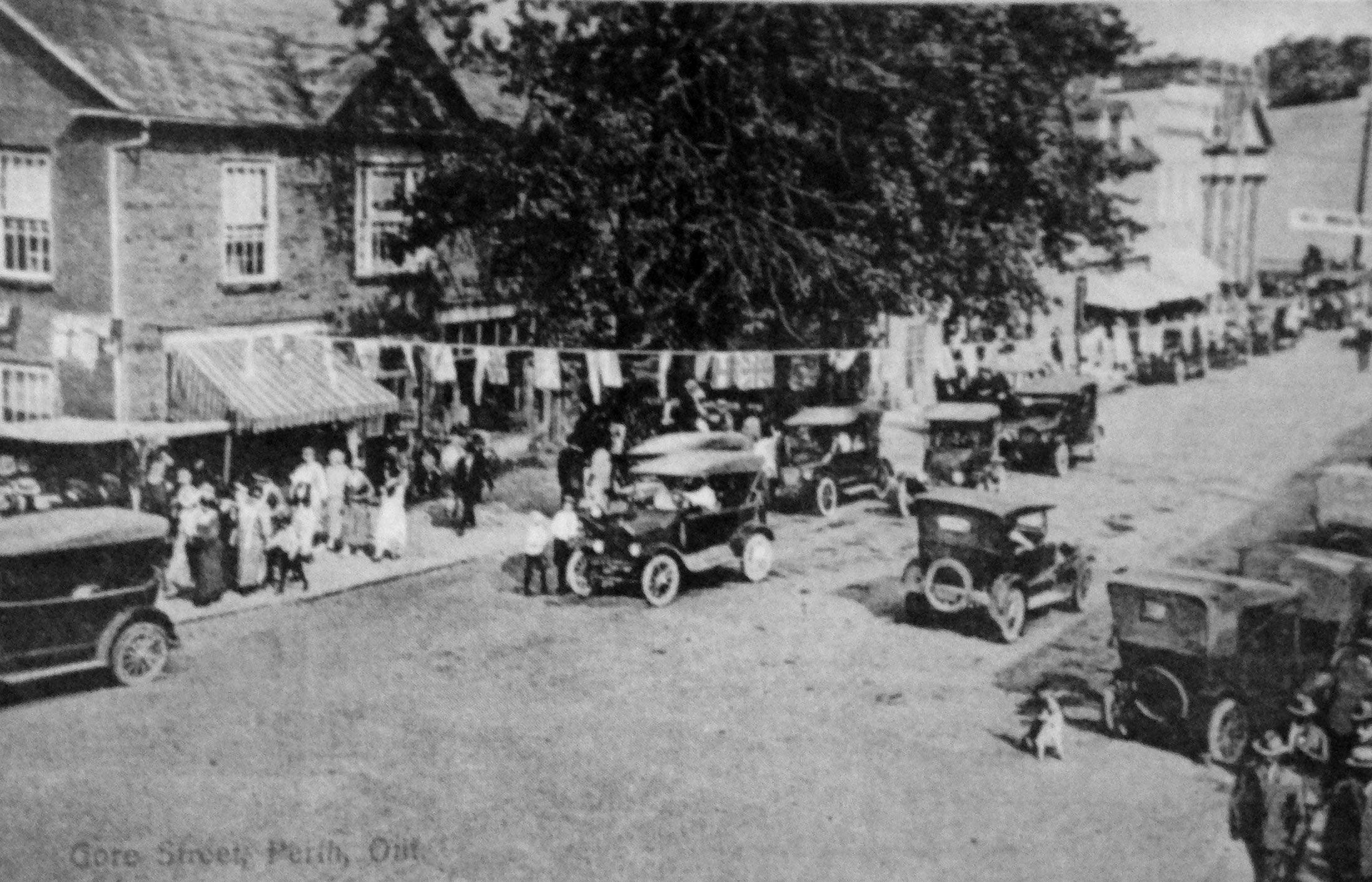
PERTH FLOOD 1926
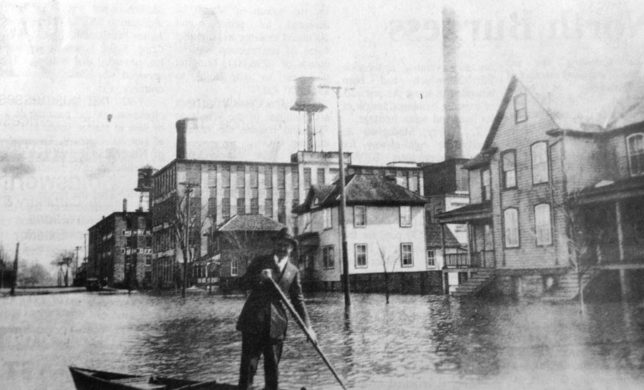
Photo shows Arthur Ralyea making his way around in a boat at the corner of North an d Sherbrooke Streets in front of the Perth Shoe Factory. Wampoles and Jergens in the background.
THE PERTH COURIER APRIL 23, 1926
A Flood in Perth Last Week. Perth Shoe Co. Employees Ferried to Work – Streets and Cellars Flooded.
Perth was the scene of a flood last week, the most serious experienced in the town for upwards of forty years. Fortunately, it only lasted for a short time and no great loss was incurred. As announced the Courier last week the two tributaries of the Tay River here overflowed their banks on Thursday and at night following that situation the section of the town from Beckwith Street embracing James Brothers Foundry, Perth Shoe Co. plant and the C.P.R. property became flooded and beyond the C.P.R. main tracks the fields were covered with water and presented a large lake-like appearance. The 2nd line road more familiarly known as the “Long Swamp” road was completely submerged with water from near the tracks to past the beginning of the McLaren swamp, the water easily reaching to the height of an ordinary wagon box, Friday and Saturday operations were ceased in James Brothers Foundry. On Friday it was impossible to use steam at the plant of the Perth Shoe Com and many of the employees were dismissed from work. The office staff and a few in other departments, however went to work but had to be ferried by boats from the foot of Foster Street and on Sherbrooke Street to the plant. The basement of the plant was cleared of certain of the stock in storage there and the firm’s loss in that respect was slight. The residences on Sherbrooke Street were practically islands as they were all surrounded by water. Beckwith Street from the skating rink corner to near the boy’s playground of the Public School was submerged by a couple of feet of water and many of the cellars of the houses in the vicinity were flooded. Saturday and Sunday the water began to gradually lower and on Monday the streets were almost in their normal condition again. Since last week the waters of the Tay have also lowered considerably and thus ended any further anxiety.
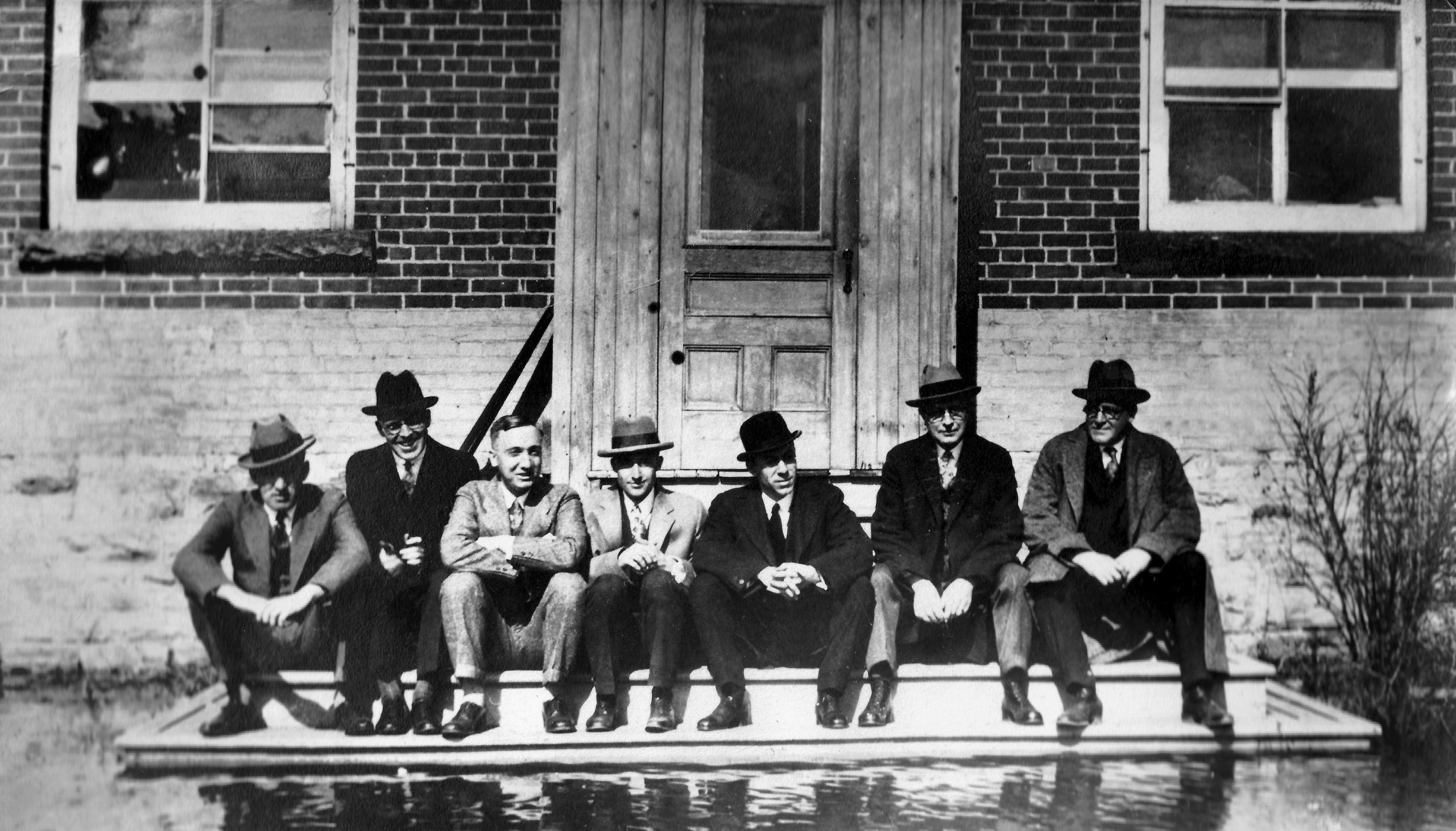
The gentlemen on the steps of the Perth Shoe Company ( later to become Brown Shoe Company) were brought down the street in a row boat. Seated left to right: E. Quartermain, H. Kelick, E. Sabistion, R. Thornbury, L. Belic, H. Pettes, G. Ansley.
THE PASSING OF HON. JOHN GRAHAM HAGGART – MILITARY FUNERAL MARCH
Thousands turn out and pay last tribute of respect to late Member. Under a dull and heavy sky in a cold and piercing March wind, with light snow flurries, the people of South Lanark paid their last tribute on Sunday afternoon to the memory of Hon. John Graham haggard, who had for forty-one years, been their representative in the House of Commons. Hon. Mr. Haggart’s body was brought to Perth last Thursday night in a special car, and taken to his home on Mill Street, overlooking the Tay River. Weraring the uniform of a privy councilor, with his hat and sword on the casket, the body was viewed by many an old friend and supporter, and the funeral on Sunday hundreds passed in and around the casket for a last look at the man who always hold the affections of the people of South Lanark. The day was raw and cold and the wind swept the high elevation on which the Haggart homestead stands in a picturesque island with swollen river and branches of the main stream babbling around it as the icy fetters of winter were breaking loose. There was a large crowd at the house, but the greater majority lined the route of procession on Mill Street along Gore and Brock to the old Presbyterian burying ground. The funeral was of a military nature. Detachments of the 452nd regiment at Perth and Smiths Falls turned out in command of Lieut. Col. Balderson. The late Mr. Haggart was born in Perth, Ont. Nov. 14, 1836. He was for some time in th4e milling business in Perth. In partnership with George Buchanan in 1832, he had acquired a lease to operate Alexander Thom’s grist mill in Perth, on what came to be known as Haggart’s Island in the Tay River. By 1840 he had erected there a cluster of carding, flour, and sawmills and a finely crafted stone house of Regency design. He was also mayor of the town in 1866, 1869 and 1873. In 1872 he was elected to represent South Lanark in the Conservative interest in the House of Commons up to the time of his death.
TRAIN ACCIDENT, GLEN TAY, 1925
STORY, TORONTO STAR
Sixteen are injured in head-on collision. One man thought seriously hurt – others receive but bruises
Perth Ont. Feb 26 Sixteen people were slightly injured, one seriously, when a C.P.R train crashed head-on into a waiting freight train at Glen Bay (sic) three miles from here this afternoon. Albert Labelle of Montreal, who is not expected to recover, is in hospital there.
An open switch threw the passenger train into a siding where the freight was standing at the station at Glen Bay (sic). The engine crew, Walter Norris and A. Bourne, Toronto leaped to safety when they saw the crash coming and escaped with bruises. Norris is the most seriously injured of the two and is in hospital here. One of the Toronto people who were slightly bruised was Mrs. J.W. Hobday of the Bernardo Homes, 538 Jarvis street, Toronto. The passengers included the Ottawa professional hockey team and a number of the players received bruises. They are Frank Ahearn, manager; G. Boucher, E. Campbell, P. Green, Alex Smith and Alex Connell. The train was the fast Canadian Pacific passenger No. 20 (“The Canadian”) bound from Chicago to Montreal. It is due in Montreal about seven o’clock to-night. Photos: The Perth Museum.
DOG SLED RACES ON GORE STREET 1954
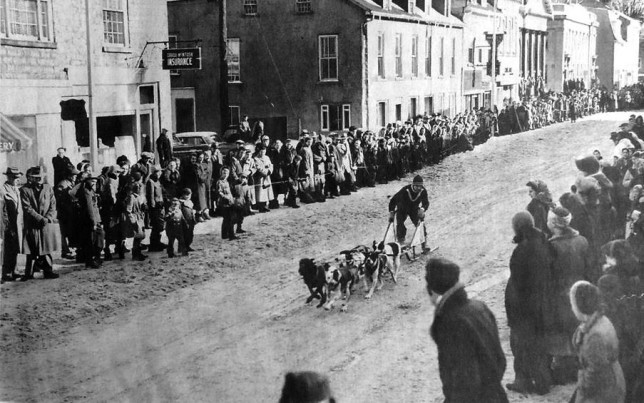
Dog-sled races on Gore Street shows a different view from today’s Gore Street. To the left is the Sherriff’s House that then housed Tayside Bakery and an Insurance Company. Harry’s Cafe sign can be seen behind the street light pole and the Library and Post Office. Snow was often brought in and spread on Gore Street for these races for this Winter Carnival Event.
PERTH WINTER CARNIVAL 1958
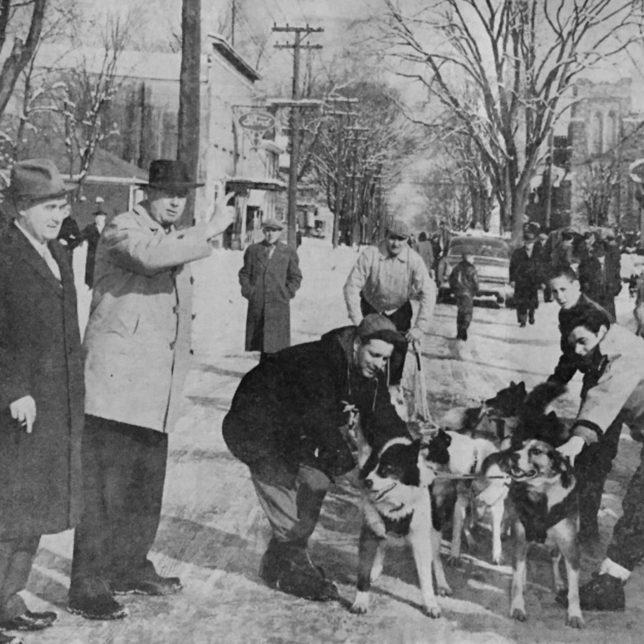
Mayor E. S. Burchell assissted by Mr. R. S. Parks, President of the Perth Chamber of Commerce, set the dog sled teams off at 2 minute intervals on the course. This picture shows the starting line near the corner of North and Gore streets. St. Andrew’s Presbyterian Church to the right in the background and James Brother’s Garage (Fred Frizell was mechanic there) to the left background. This building was bought by Bell Canada and demolished in 1962. Bell switching station is in that location now. The dogs completed the 18-mile course through Perth in times varying from 1 hour, 43 minutes to 2 hours 10 minutes.
THE GHOSTS OF BURGESS

The photo on the left is the Quinn home as is was in 1967. The photo on the right of a number of personalities who made the “Burges Ghost” come to life in 1935. (L-R.) John Quinn, Mrs. Quinn, Inspector Oliver, Patrick Quinn, Sergeant Story and James Kinlock. Photos and story The Perth Courier.
From a story by Don Rennie, The Perth Courier 1967.
Strange occurrences were happening in 1935 at a farm in North Burgess just off the Narrows Locks road. Mr. John Quinn, his wife and two children, Michael, and Stanley, ages 13 and 11, reported innumerable phenomena taking place in their home. Stove lids, according to the Quinns, “danced” in the air, the teapot “jumped” off the stove into the wood box, three flat irons “walked” down a staircase and dishes “pranced” on the dining-room table. Word of this mysterious goings on spread quickly throughout the district. Although, perhaps skeptical, hundreds of persons from miles around flocked to the Quinn home.
On the Sunday after the reporting of the “ghosts” more than 100 cars arrived at the Quinn farm. Along with the cars a flotilla of cutters and sleighs dotted the white-capped farm. The snow fell incessantly and the thermometer dipped way below the zero mark.
Newsmen from across the country arrived and the CBC news from Toronto reported the strange events. Although the strange occurrences could not be readily explained many held doubts in their minds as the credulity of the phenomena. Believing that there had to be a reasonable explanation behind the occurrences the Perth detachment of the OPP decided to hold an investigation.
On a Saturday afternoon members of the force motored to the Quinn home and inspected the building. Nothing strange occurred while they were there. That same evening Inspector Storey returned to the house. He remained there until Sunday morning along with about a dozen district men sat in the house speaking in hushed tones but again nothing happened.
Mr. Quinn was unable to explain the strange occurrences that had been going on for the past couple of weeks. Pieces of beef he had placed in a barrel had been found littered throughout the house, he said, and the Wednesday before a window pane crashed for no apparent reason. He had not thought that too odd until it happened the very next evening.
Andrea Burke, a neighbouring farmer, declared that a bone thrown out of the home time and time again had always returned to the house for no explicable reason. Another neighbour, William Cordick, swore that he had seen three flat irons descend the Quinn’s staircase one after another.
For almost two months the mystery remained unsolved. Then in March the “ghost” was discovered.
Michael Quinn, the eldest son of Mr. Quinn, was arrested by the OPP and charged with the burning down of a barn belonging to Mr. M. McParland.
The boy, while being questioned in the arson case, readily admitted that he was the “ghost” of the Quinn ho me.
The youth was examined by a Kingston doctor and was found to be in no way insane and the boy subsequently spent time in an Ontario reformatory.
The accepted reason, by most, behind the creation of the Burgess “ghost” was that Mrs. Quinn wanted to leave their farm and move but her husband was quite happy there and was unwilling to move. Therefore his wife canvassed the help of the “ghost”.
The Quinn family was long gone by 1967 but the farm house, seen here, still stood on a knoll overlooking the district reminding all who remember about the “Burgess Ghost”.
OLD HOME WEEK 1948
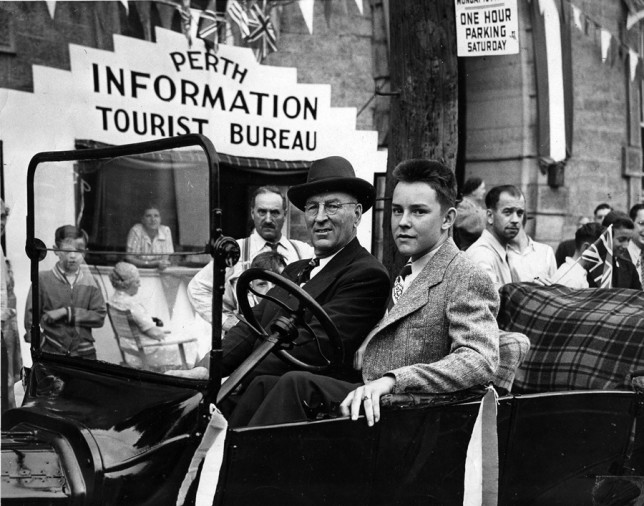
Mary Cooper, sitting in rocking chair, Tootie Gray in Tourist Bureau Booth, Dr. Stencill, Mayor J. Pennett, Bob McTavish, Cliff Clark. Photo courtesy of: Patti Koeslag (McParlan). Photos of parade below, courtesy of: Shirley Brousseau
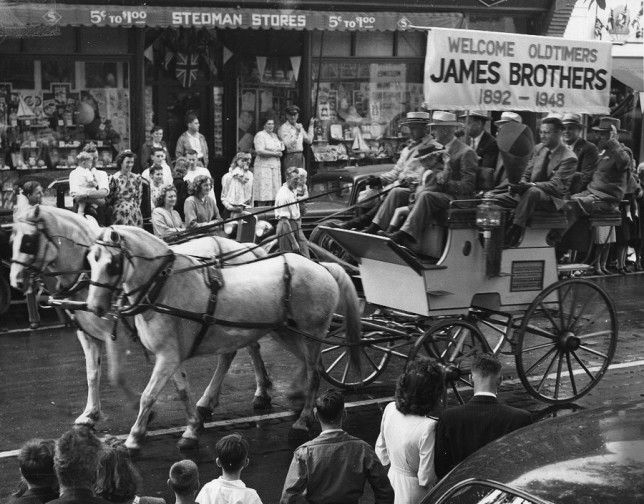
George James holding Grandson George James, Alan James directly behind and beside him Lawrence James with Henry Palmer in back seat. The “Tally-HO” that they are riding in was given to the James’ by Barnum and Bailey Circus. Photo courtesy of: Patti Koeslag (McParlan).
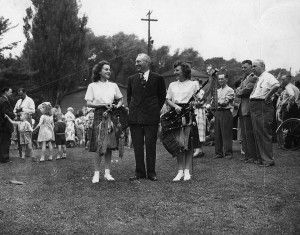
Fred Hanna, Walter Stemp, Jim Duncan, Len McQuatts wife (with pipes), Mayor J. Pennet, Mrs. McQuatts sister, Leo Mulholland, Earl Darou, Walter McKee, Herb King. Photo: Patti Koeslag (McParlan)
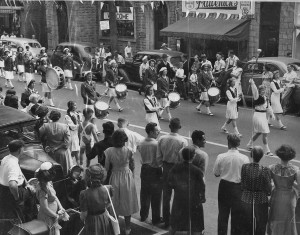
Prescott High School Girls Band marching past Pattenicks Store on Gore Street: Patti Koeslag (McParlan)
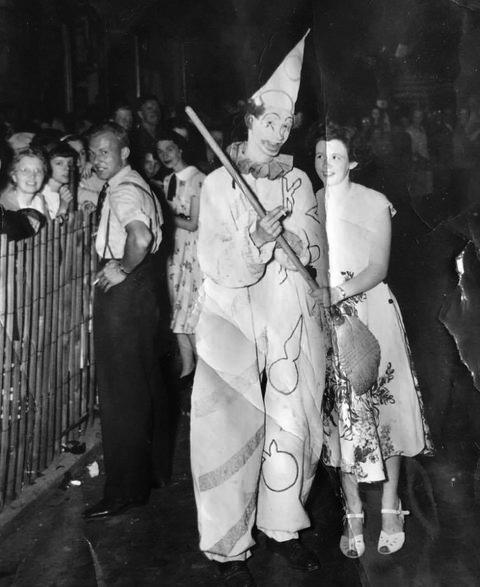
To the right of clown by the fencing is Donald Jordan and his wife Jean Jordan just over his right shoulder. Photo courtesy Scott Gordon.
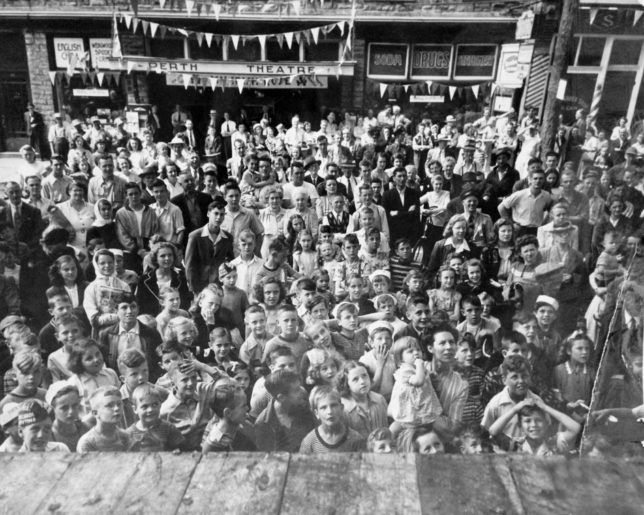
PERTH OLD HOME WEEK 1948 A crowd of young and old gather in front of the Perth Theatre to watch performers on a stage, on Gore Street during Old Home Week, 1948. Some of the people that were identified in the Courier caption that appeared with this photo: Ken Barr, Sandra Barr, Bill Howie, Carol Evans, Martha Church, Earl Darou, Barb Phillips, Helen Benson, Joanne Beaman, Barbara Church, Jackie Charboneau, Eric Rogers, Gail Merril, Beryl Watt, Bob Parks, Jack Watt, Cliff Moore, Carl Oakes, Audrey McCord, Kathleen Beaman, Carl Paul, Caroly Carson, Arlyn Carson, Madalyn McGinnis and Jane Barrie. Photo courtesy The Perth Museum.
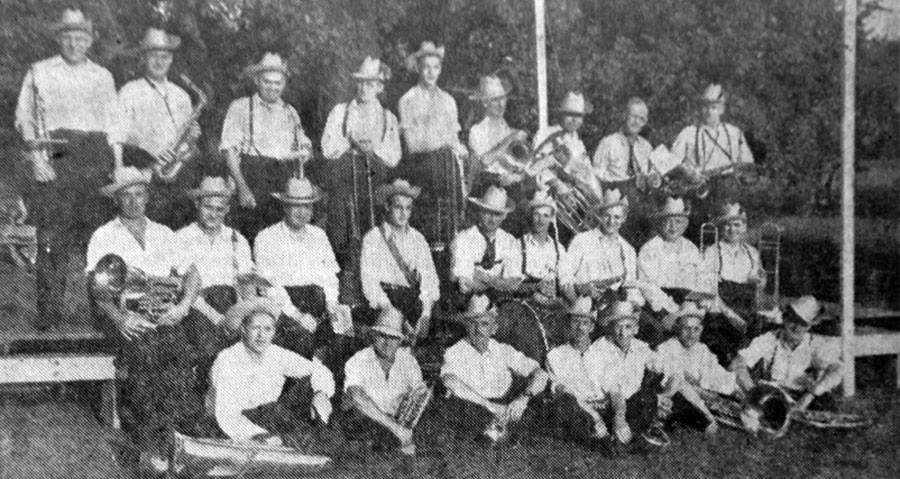
Musicians of the Oldtimers’ Band. Front row, left to right; Al Stocker, Vic Ottman, Deb Oakes, Dick Mills, Caleb Strong, A. Delisle, Frank Cole. Second row, left to right; George Nichols, Bill Nichols, Fred Nichols, Don Cowie, Bob Nixon, John Turner, Ken Burns, John Howie, Vic Young. Third row, left to right; Hal Burns, Harold Keitel, Joe lark, Russ Griffiths, Frank Cowie, Garnet King, George Saunders, Harry Liscombe, Dave Hart.
TAY FIRE COMPANY 1895
TRAIN WRECK, PERTH 1910
SPRING FLOOD 1926
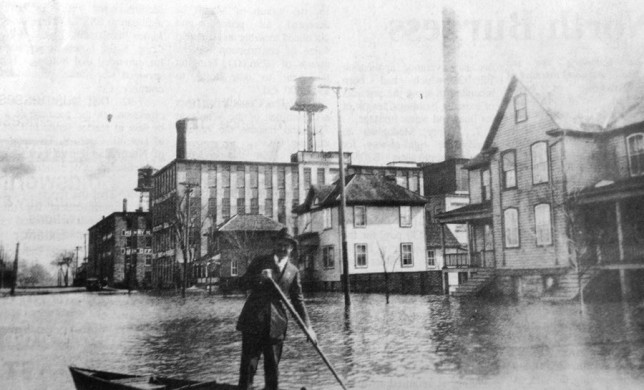
April 1926 shows Arthur Ralyea making his way around in a boat. Henry K Wampoles in the far distance with Jergens foreground.
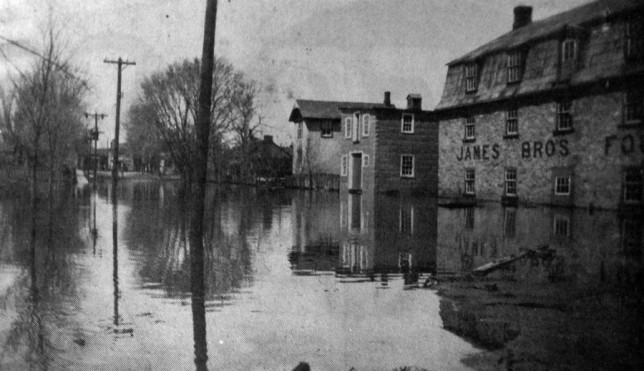
Beck with Street showing James Brothers Foundry (originally Templeton’s Tannery), the adding storage shed covered with metal siding and the tall house just beyond. These buildings were demolished to make way for the Federal Building and Post Office.
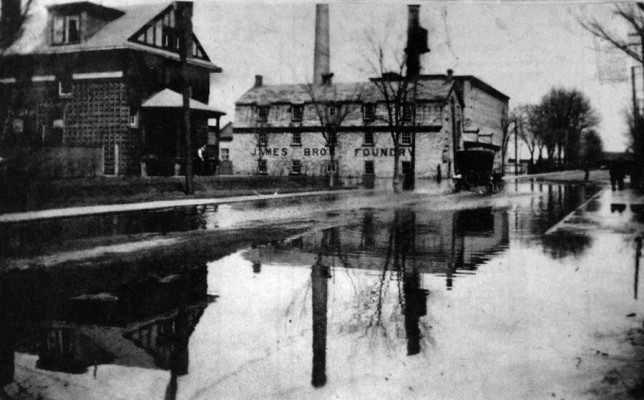
A view of James Brothers Foundry on Herriott Street and Beckwith Street. To the right the new housing built for Wompoles that replaced the original Curling Rink at this location.
PERTH AIRPORT
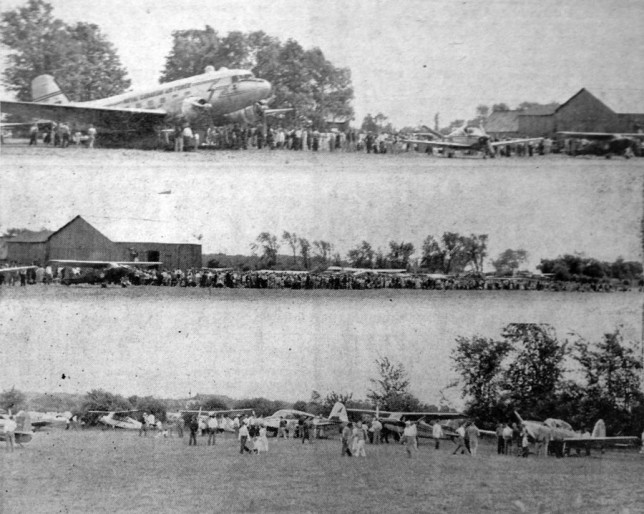 n 1956 the Perth Airfield was opened on Saturday, August 25th. There was a 3,000 foot runway with a width of 500ft. Landing lights were installed. A customs office was available for incoming planes. 3,500 people attended the opening of the airfield. There was an air show with four T-33 jet trainers making low sweeps before returning to base at Trenton. Three Harvards also from Trenton gave a display of formation flying and aerobatics. A DC-3 from the air search and rescue division at Trenton was a great attraction. This plane landed in the morning and was open to the public for inspection throughout the day. More than 30 planes from various flying clubs in Ontario and Quebec were also lined up for inspection and proved very interesting to the audience. The show was brought to a close when three CF-100’s from Ottawa made a fly-past in salute to Perth’s new airport. In 1958 World Wide Airways applied for a franchise to fly regular daily passenger services with a flight route from Toronto, Oshawa, Peterborough, Trenton, Kingston, Perth Ottawa, Cornwall and Montreal. The service would also include flights to the US. The franchise was never obtained. There were three airshows since the opening of the airport and in 1959 before a large crowd of 1,500 people one pilot and a passenger crashed to their deaths in a The plane that crashed was an L19 Bird Dog. It was an army photo reconnaissance plane.. By now the airstrip was basically used by local pilots and flying clubs.
n 1956 the Perth Airfield was opened on Saturday, August 25th. There was a 3,000 foot runway with a width of 500ft. Landing lights were installed. A customs office was available for incoming planes. 3,500 people attended the opening of the airfield. There was an air show with four T-33 jet trainers making low sweeps before returning to base at Trenton. Three Harvards also from Trenton gave a display of formation flying and aerobatics. A DC-3 from the air search and rescue division at Trenton was a great attraction. This plane landed in the morning and was open to the public for inspection throughout the day. More than 30 planes from various flying clubs in Ontario and Quebec were also lined up for inspection and proved very interesting to the audience. The show was brought to a close when three CF-100’s from Ottawa made a fly-past in salute to Perth’s new airport. In 1958 World Wide Airways applied for a franchise to fly regular daily passenger services with a flight route from Toronto, Oshawa, Peterborough, Trenton, Kingston, Perth Ottawa, Cornwall and Montreal. The service would also include flights to the US. The franchise was never obtained. There were three airshows since the opening of the airport and in 1959 before a large crowd of 1,500 people one pilot and a passenger crashed to their deaths in a The plane that crashed was an L19 Bird Dog. It was an army photo reconnaissance plane.. By now the airstrip was basically used by local pilots and flying clubs.
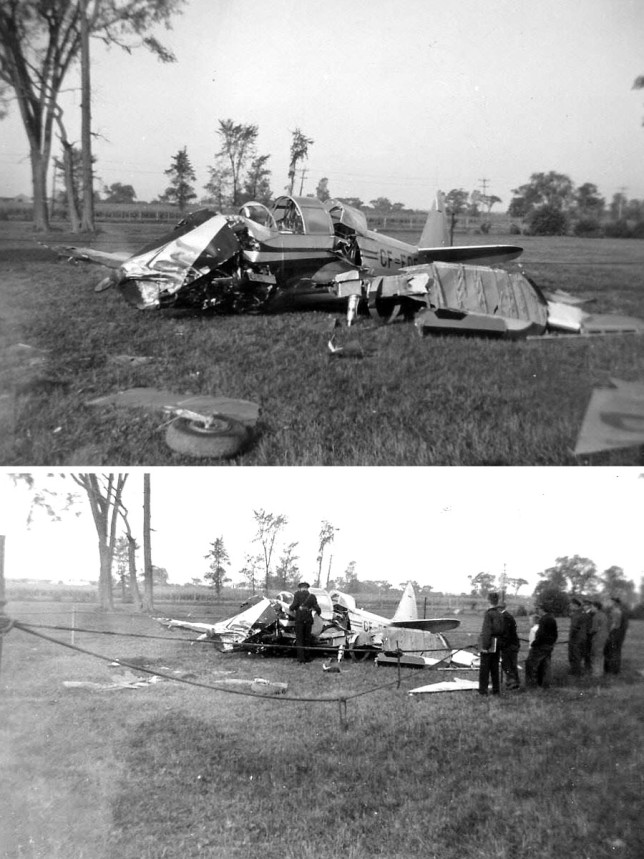 The airport got new life in 1964 when the first Commercial Airplane landed. Many attempts were made to make the airstrip viable and by 1970 town council was still debating the merits of an airport. In 1976 the land at the airport was in discussion in town council again with a proposed shopping center on the site. The airstrip was still used in the summer during this time but was dismantled in order to accommodate the new Albany International plant in the early 1980’s
The airport got new life in 1964 when the first Commercial Airplane landed. Many attempts were made to make the airstrip viable and by 1970 town council was still debating the merits of an airport. In 1976 the land at the airport was in discussion in town council again with a proposed shopping center on the site. The airstrip was still used in the summer during this time but was dismantled in order to accommodate the new Albany International plant in the early 1980’s
SOAPBOX DERBY 1949
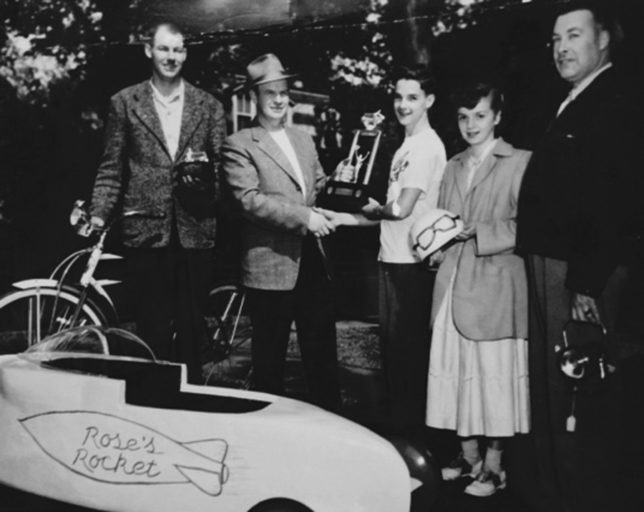
1949 Winner of the J. A. Rose Memorial Trophy-Kinsmen Coaster Classic, Merv Roberts. Left to right; Ed Grainger, H. Charbonneau, Merv Roberts, Beverly Rose, W. G. Sawdon. Photo courtesy The Perth Museum.
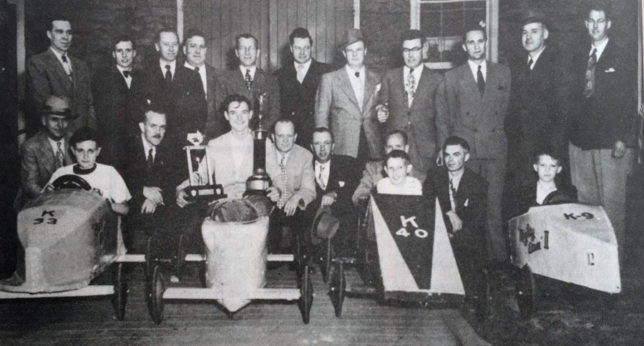
1950 KINSMEN CLASSIC. Back row, from left; Russ Ellis, unknown, Gus James, HowardNorman, Stan Tufts, Bert Headrick, Harol Charboneau, Bill Sawdon, Charlie Temple, Bob Craig, Edwin Granger (president). Front row, from left; Bill Wilson, Boyde Sheridan, Al Smith, Merv Roberts, Angelo Rubino, Clarence Duncan, Mitt Cameron behind Gerry Sawdon, Stuart Ferrier, Charlie Grainger.
SANTA COMES TO PERTH
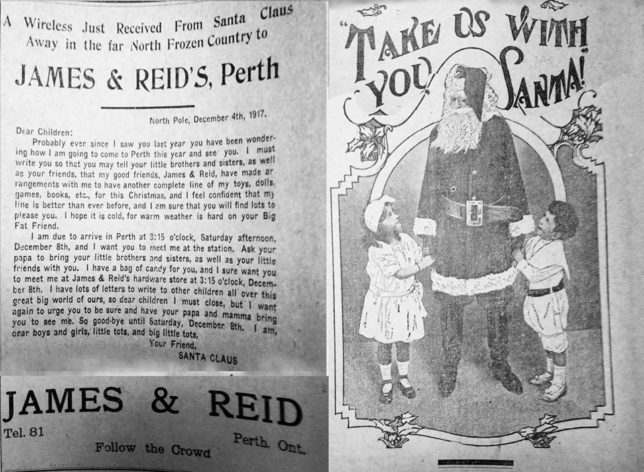
Dear Children: Probably ever since I saw you last year you have been wondering how I am going to come to Perth this year and see you. I must write you so that you may tell your little brothers and sisters, as well as your friends, that my good friends, James & Reid, have made arrangements with me to have another complete line of my toys, dolls, games, books, etc, for this Christmas, and I am sure that you will find lots to please your, I hope it is cold, for warm weather is hard on your Big Fat Friend.
I am due to arrive in Perth at 3:15 o’clock, Saturday afternoon December 8th, and I want you to meet me at the station. Ask your papa to bring your little brothers and sisters, as well as your little friends with you. I have a bag of candy for you, and I sure want you to meet me at James & Reid’s hardware store at 3:14 o’clock, December 8th. I have lots of letters to write to other children all over this great big world of ours, so dear children I must close, but I want again to urge you to be sure and have your papa and mamma bring you to see me. So good-bye until Saturday, December 8th. I am, dear boys and girls, little tots and big little tots., Your Friend Santa Claus.
SANTA CLAUS AT PERTH DECEMBER 1917
Santa Claus arrived in Perth last Saturday afternoon and spent some time at James & Reid’s store, where he gave away a thousand bags of candy to the young people and wished all a Merry Christmas. He was escorted from the train station by the band on a large and gaily bedecked sleigh. A young reindeer also accompanied him. Gore Street was crowed with people on his arrival.
Even in 1917 the commercialization of Christmas with the big push to sale toys. You always think that it is a more recent thing and forget about the anticipation of early arrival of Simpson’s and Eaton’s Christmas catalogues.
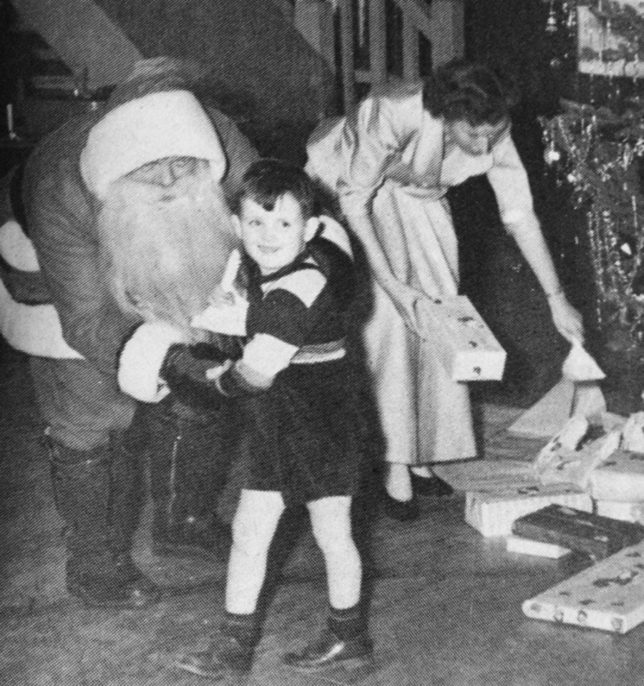
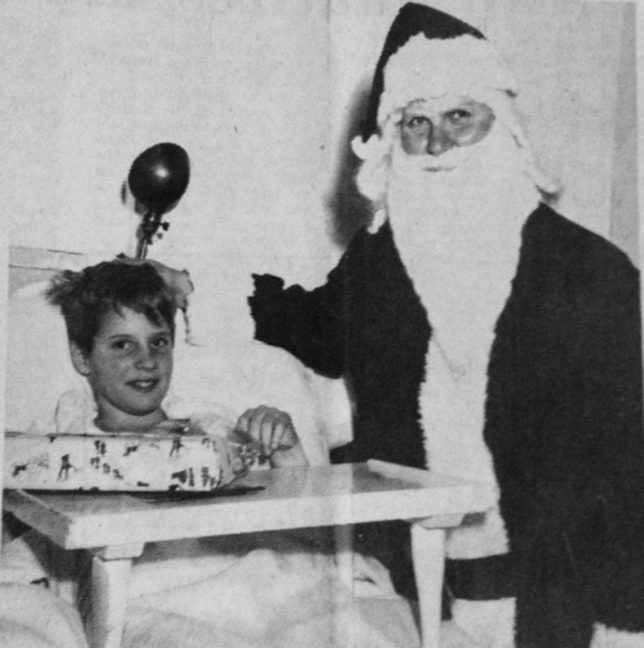
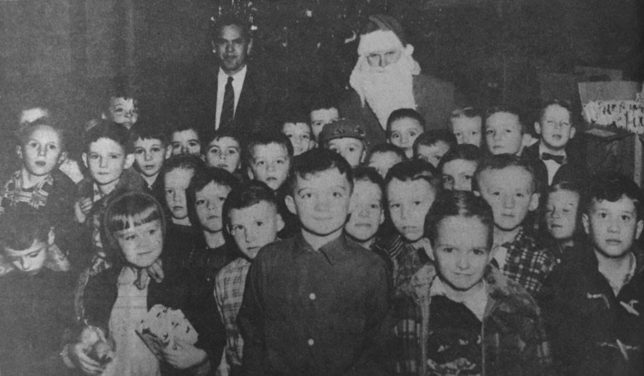
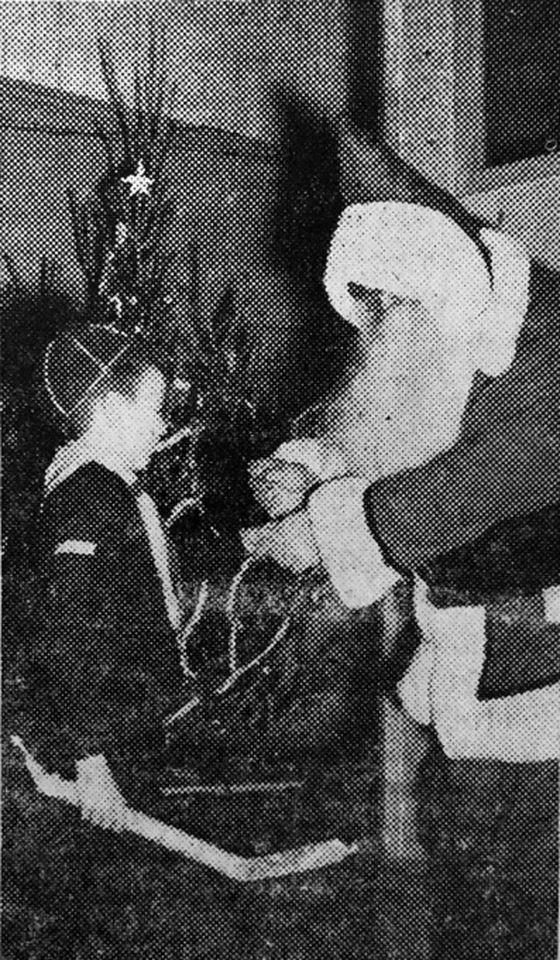
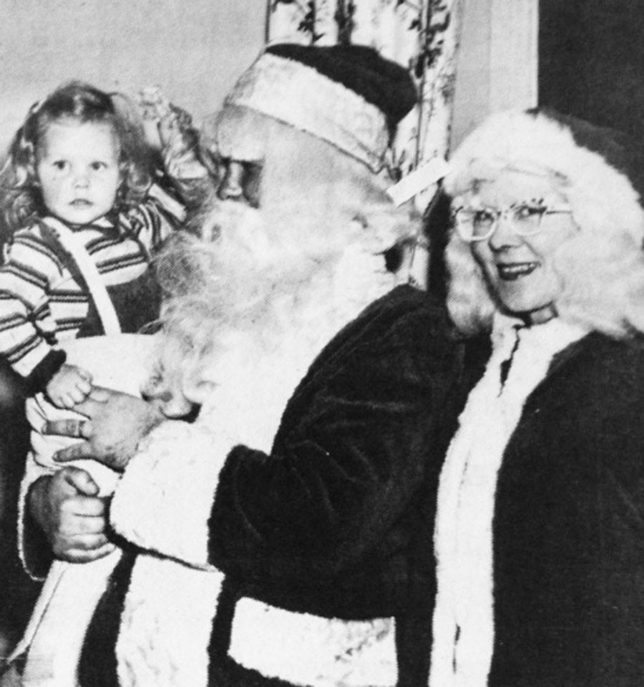
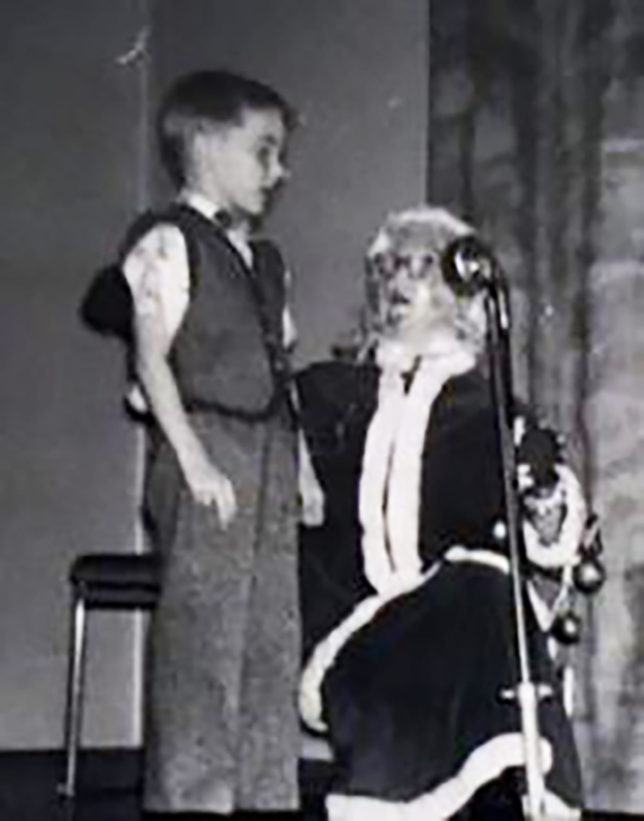
CROWDS WELCOME SANTA CLAUS – DISTRIBUTE 2,000 BAGS OF CANDY
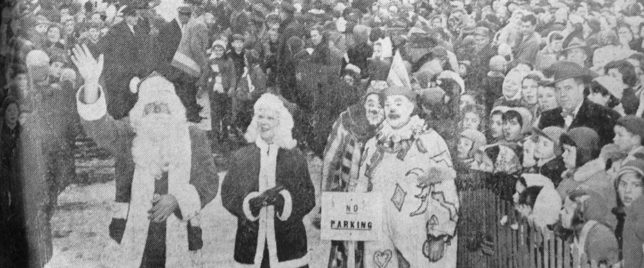
No doubt the weatherman attracted the record – breaking crowd which lined both sides of the route of the parade as it moved through the streets. Solid masses of people packed the sidewalks from the intersection of Halton and Gore to the Imperial Hotel.
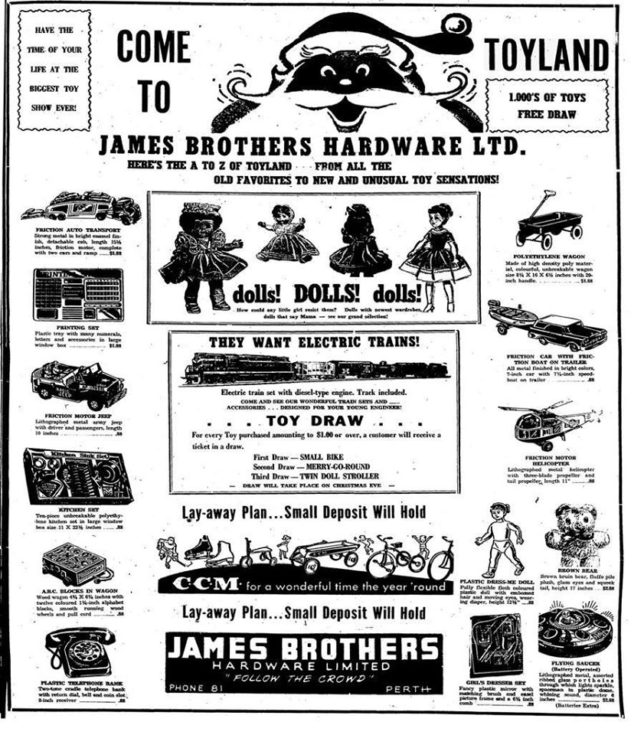
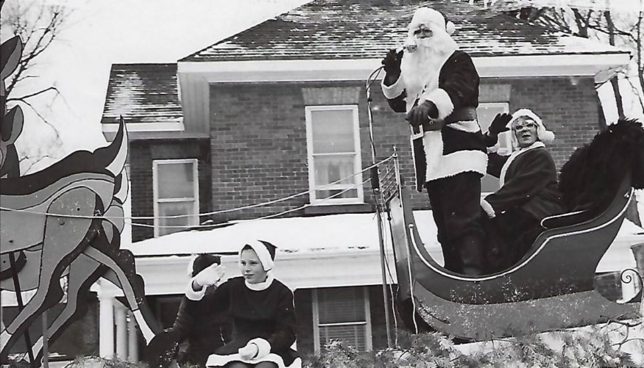
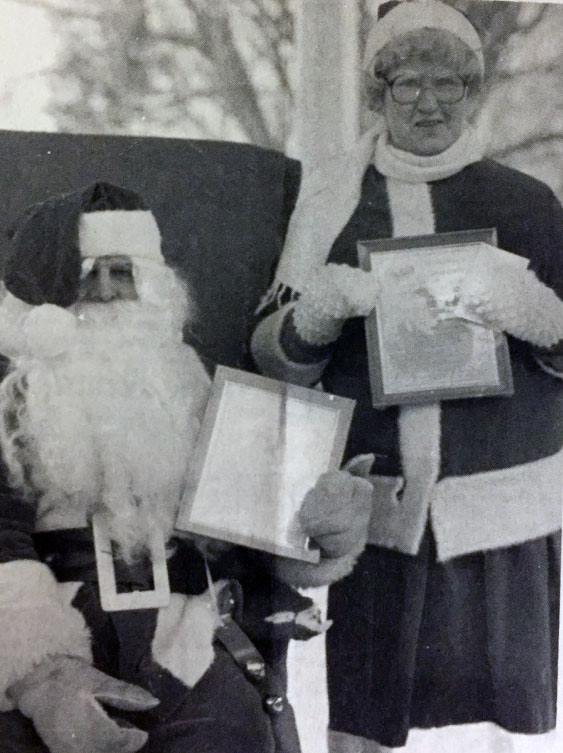
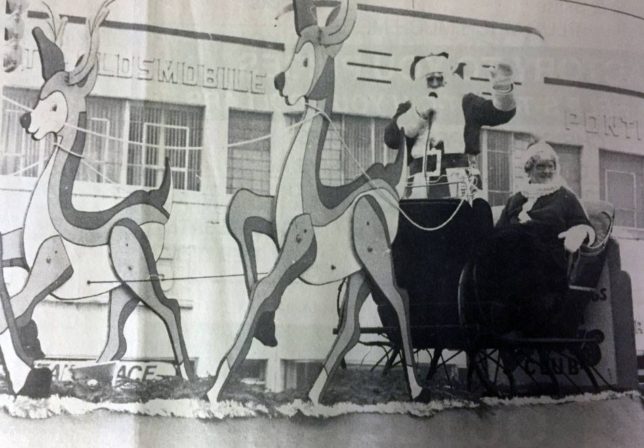
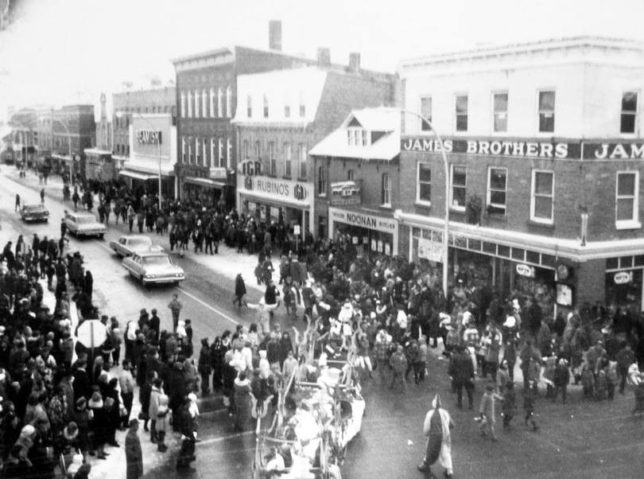
PERTH CENTENNIAL CELEBRATIONS 1967
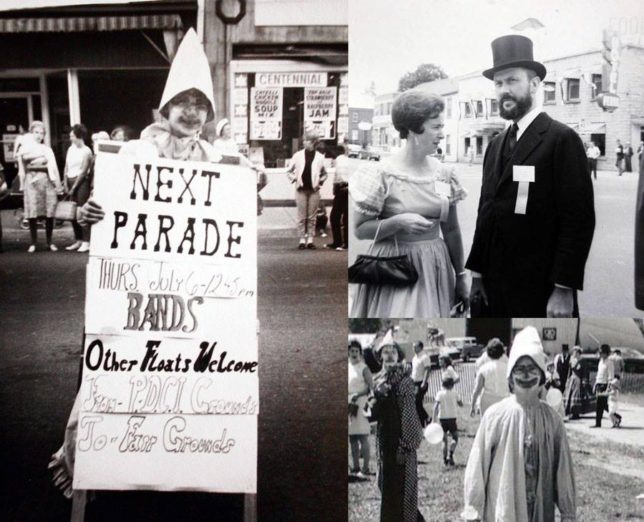
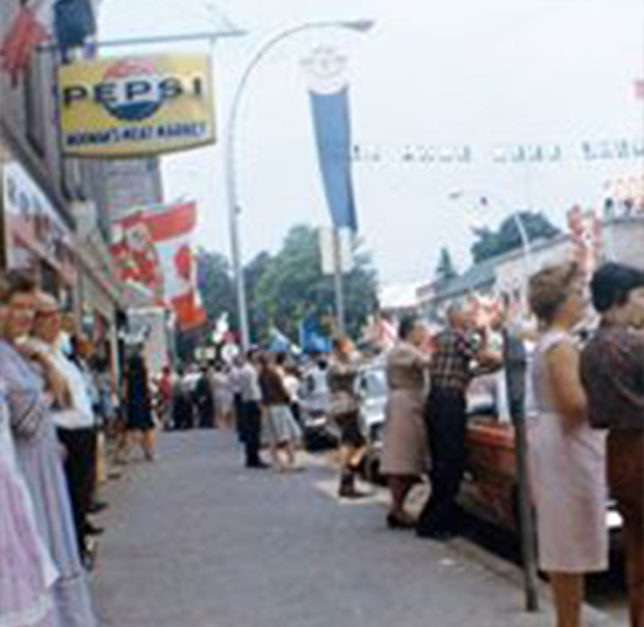
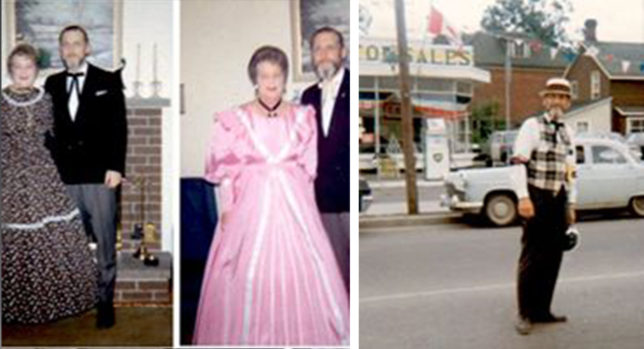
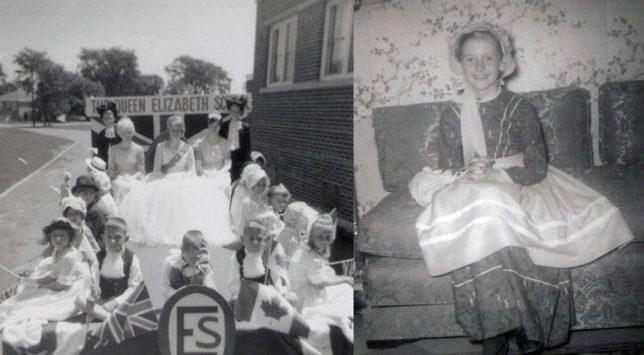
PERTH SUMMER FESTIVAL 1971
July 1971 for the week-long Perth ’71 Festival. in the Perth Community Centre was none other than Stompin’ Tom Connors — he played there for seven straight nights July 17-23. The Perth ’71 showpiece was a 1600 square-foot floating stage in Stewart Park. Canadian rockers Crowbar opened the Stewart Park shows on Friday 16 July, followed by Mike Graham (Jul 17); Ian and Sylvia (Jul 19); Ocean (Remember them? Gospel-themed rock / Jul 20); Home-grown Fred Dixon and The Friday Afternoon (Jul 21); The Stampeders (Jul 22); Rich Little (Jul 23) and Lynn Anderson (Jul 24).
